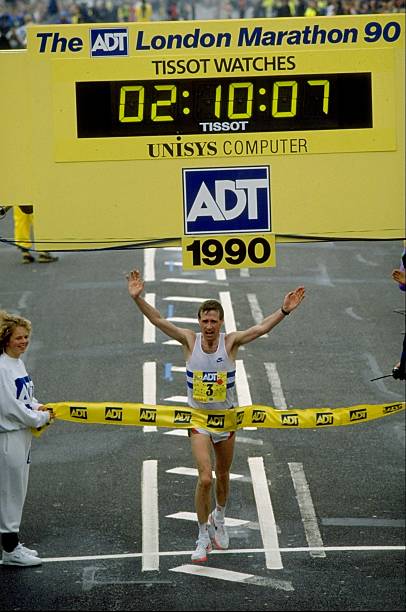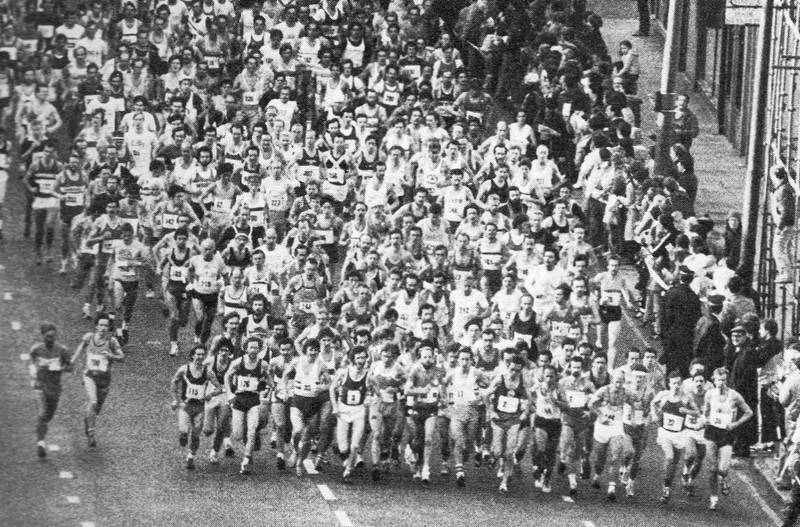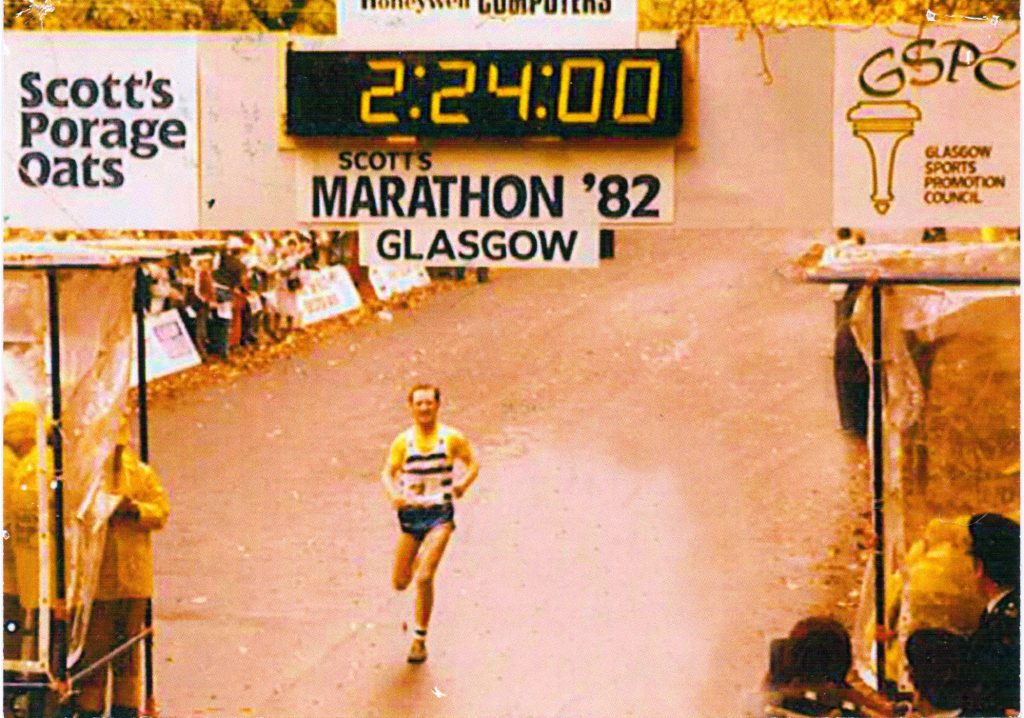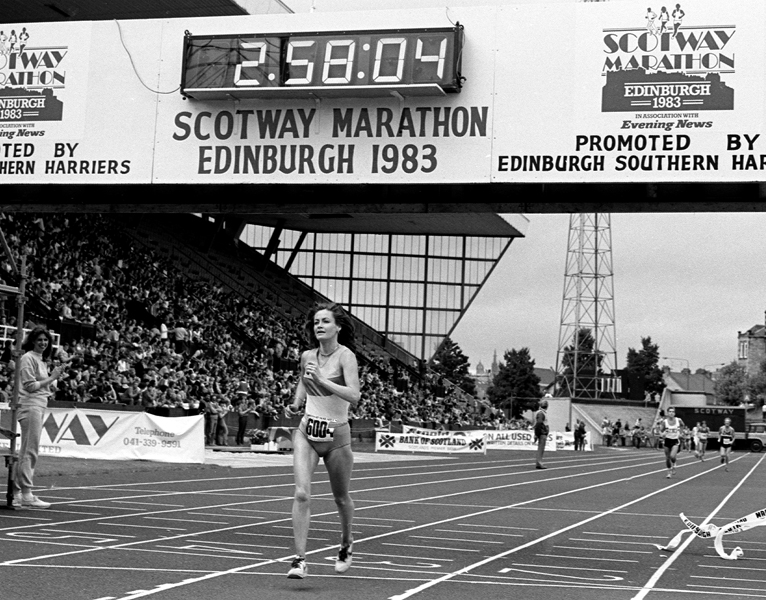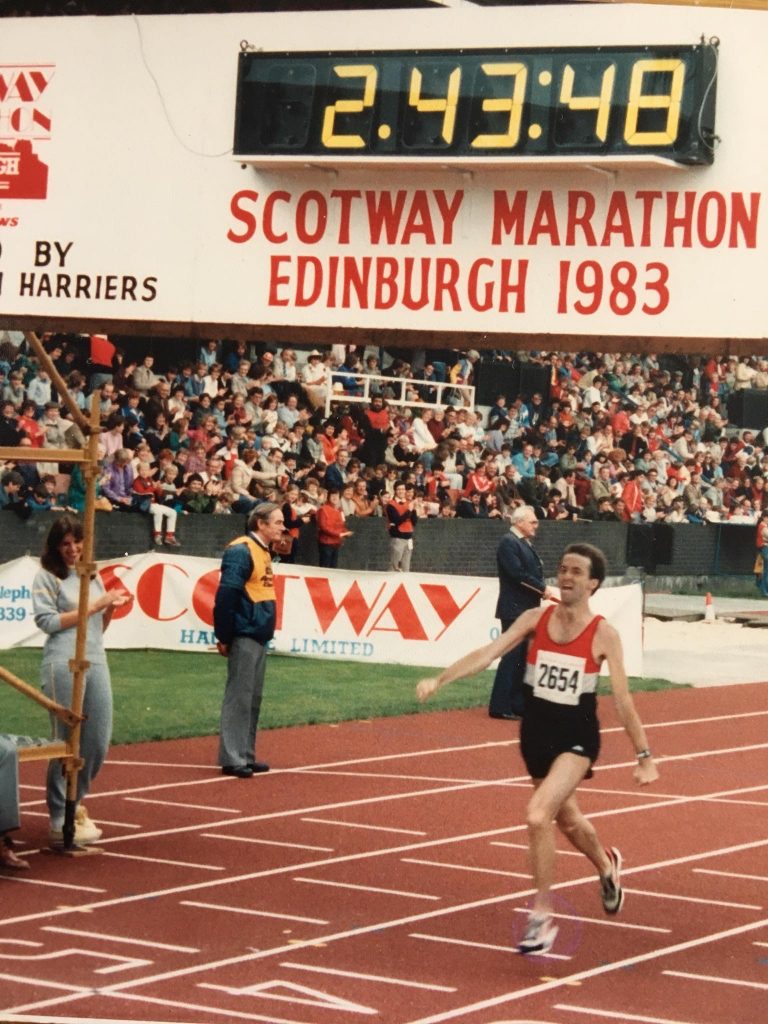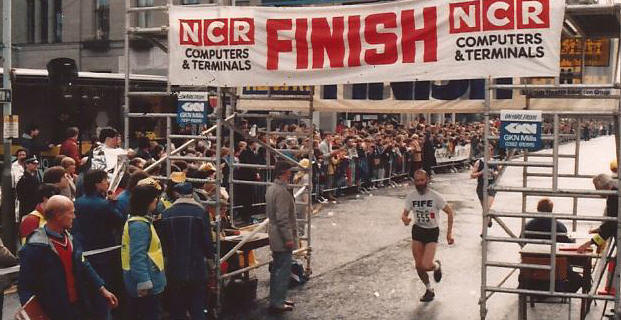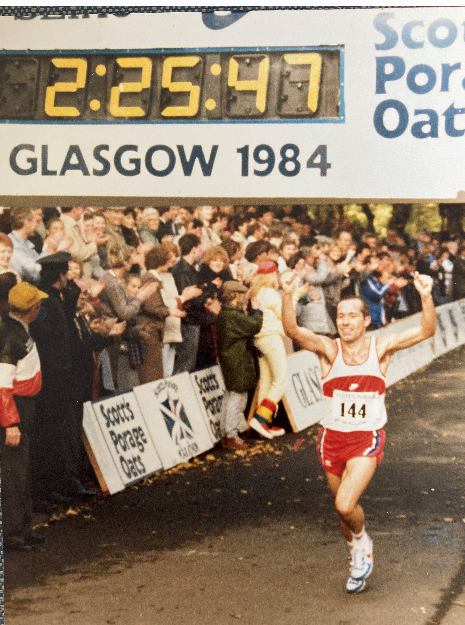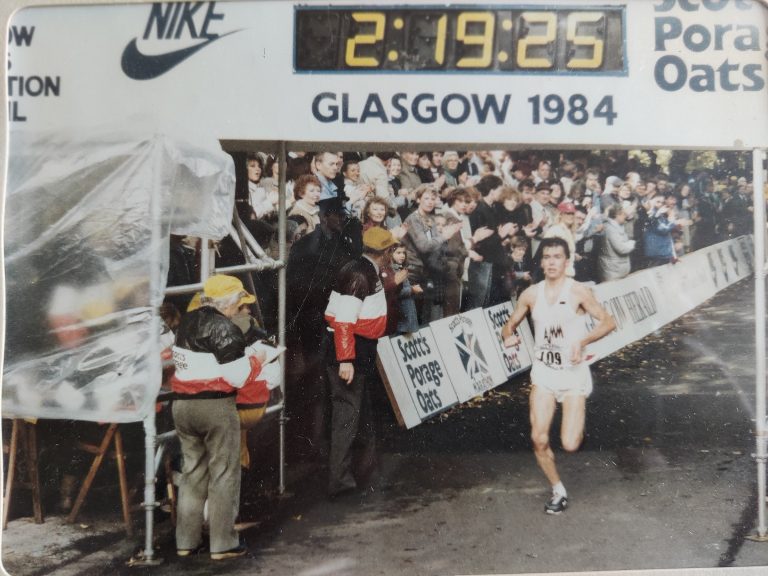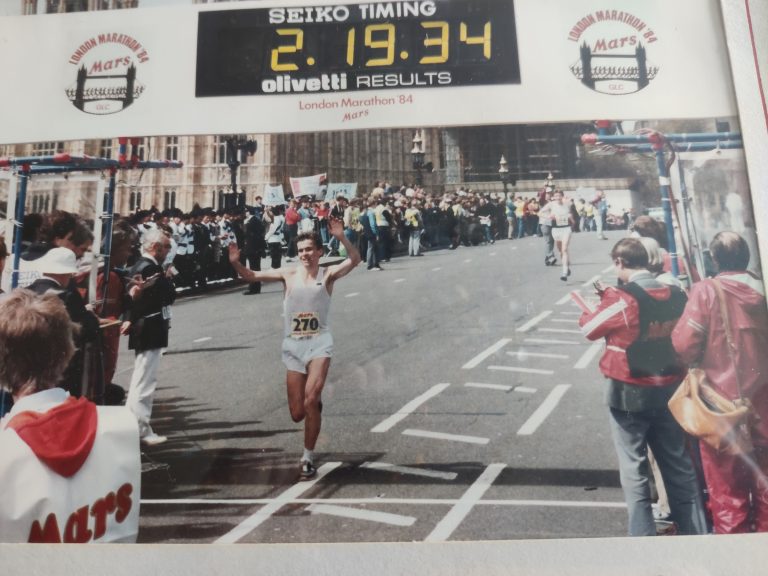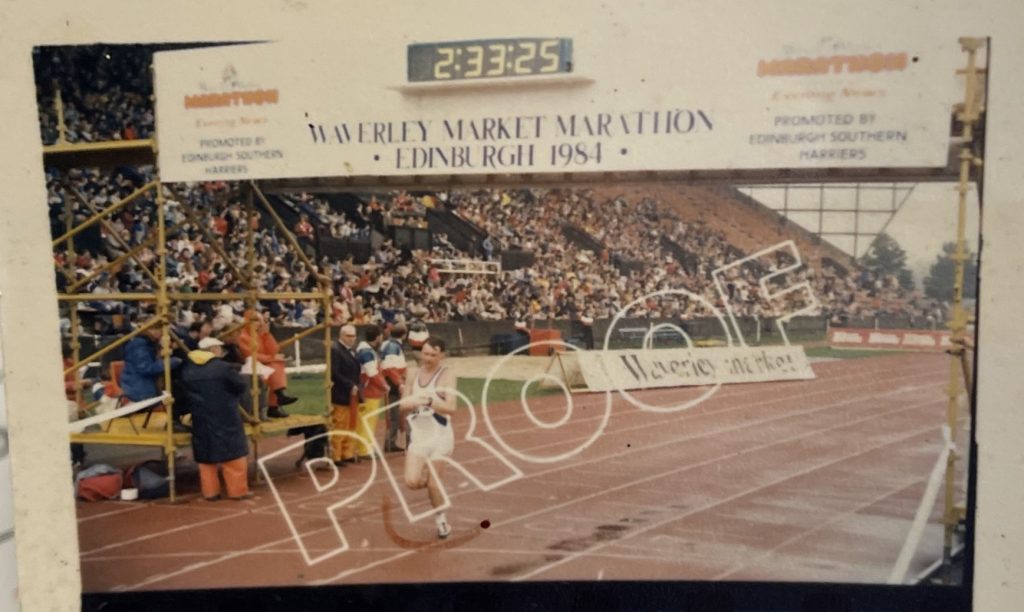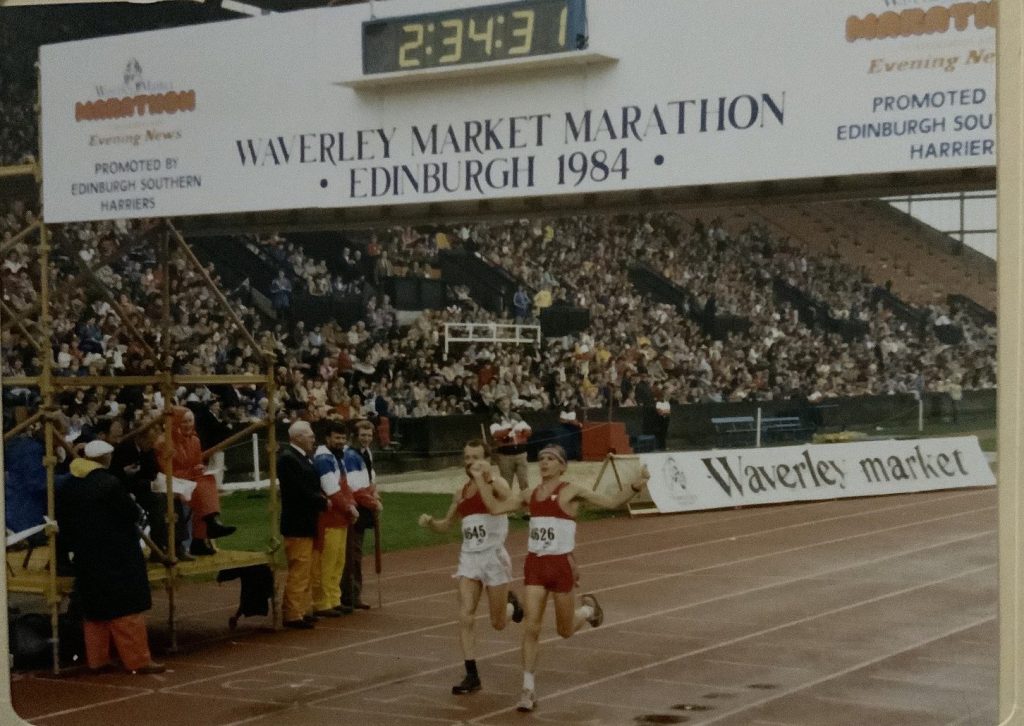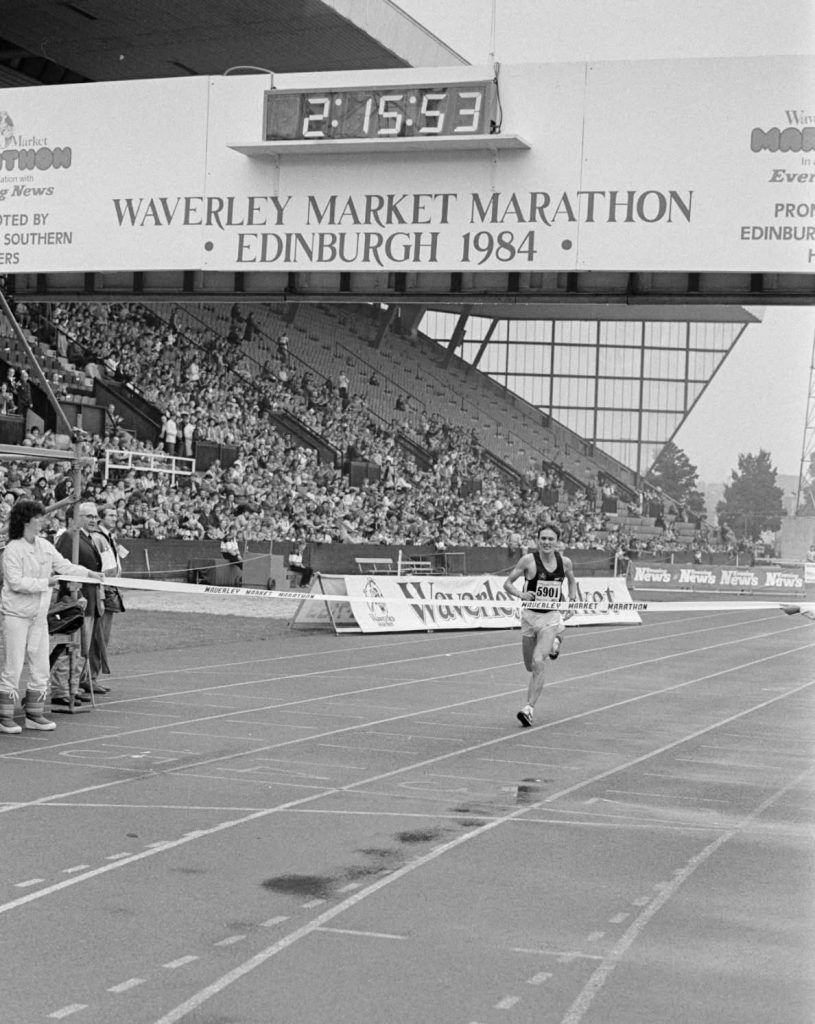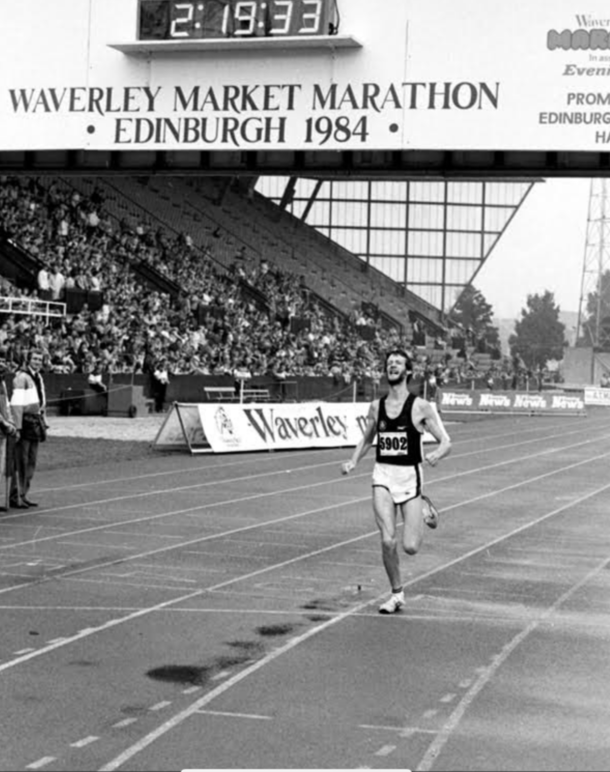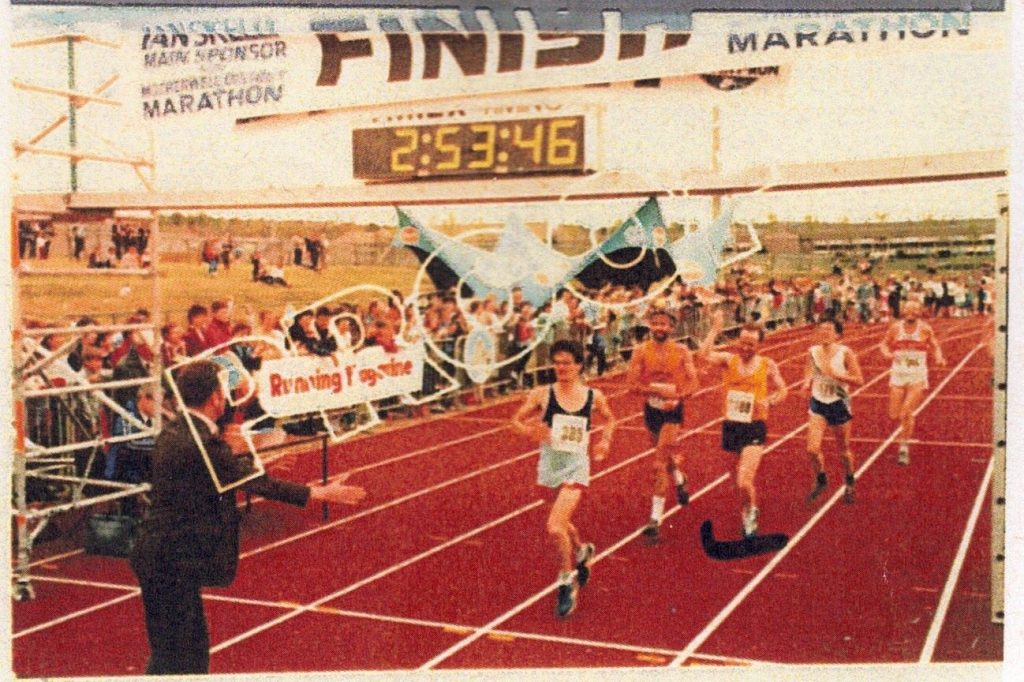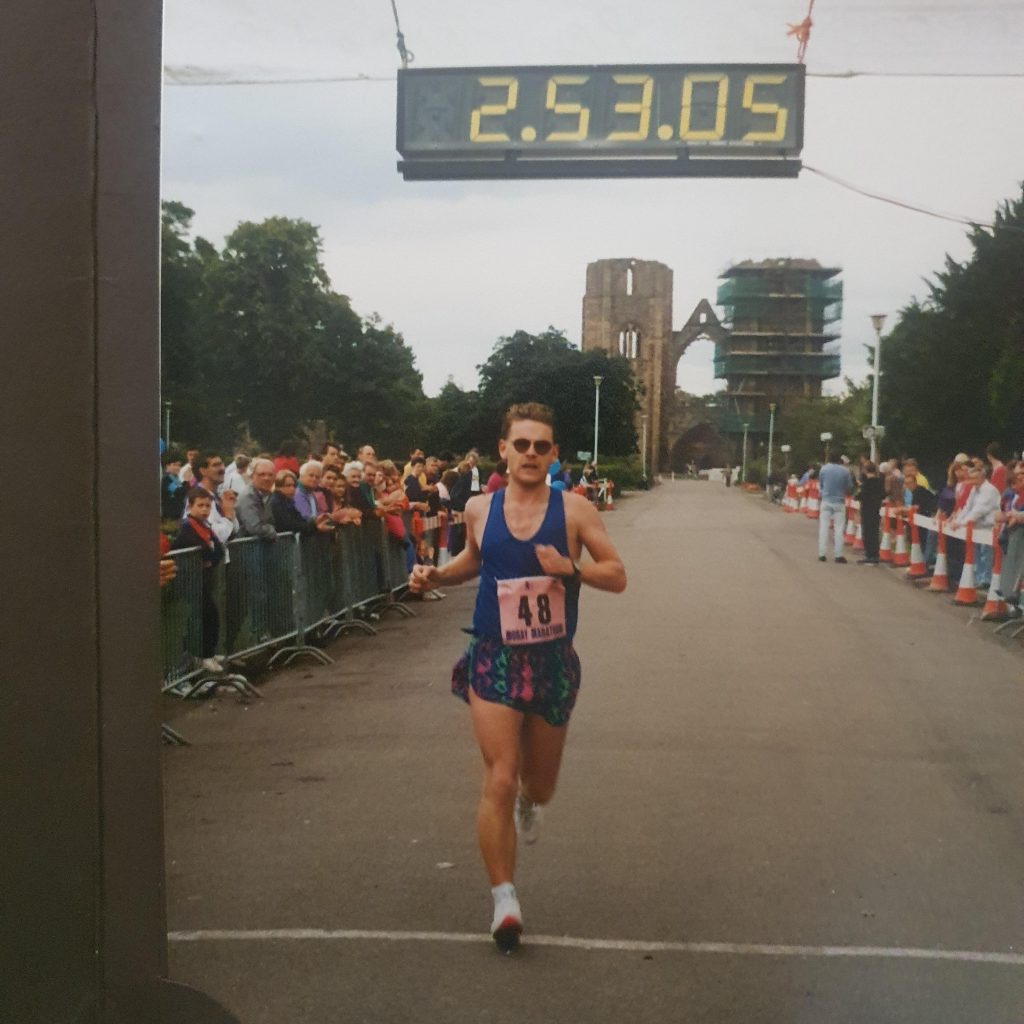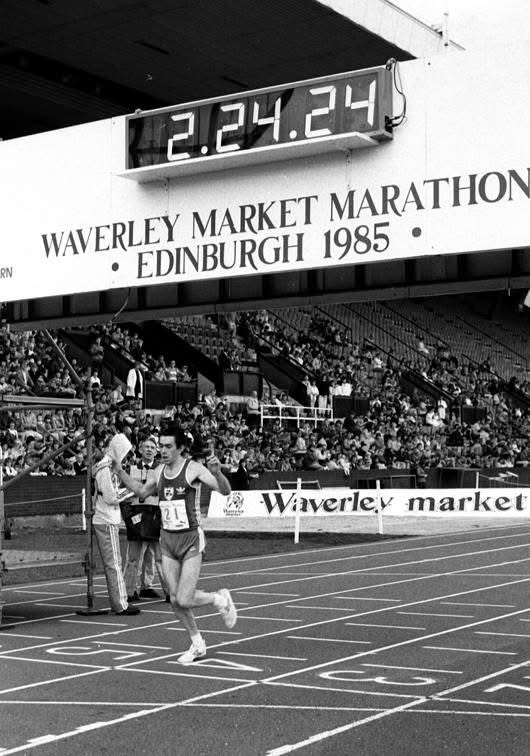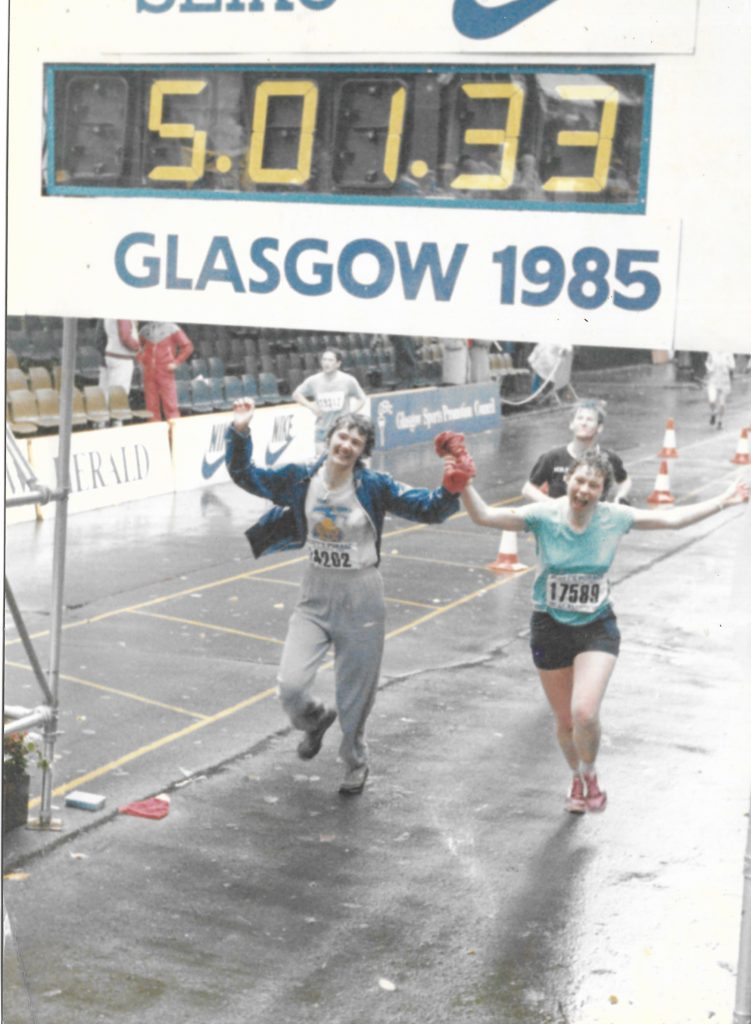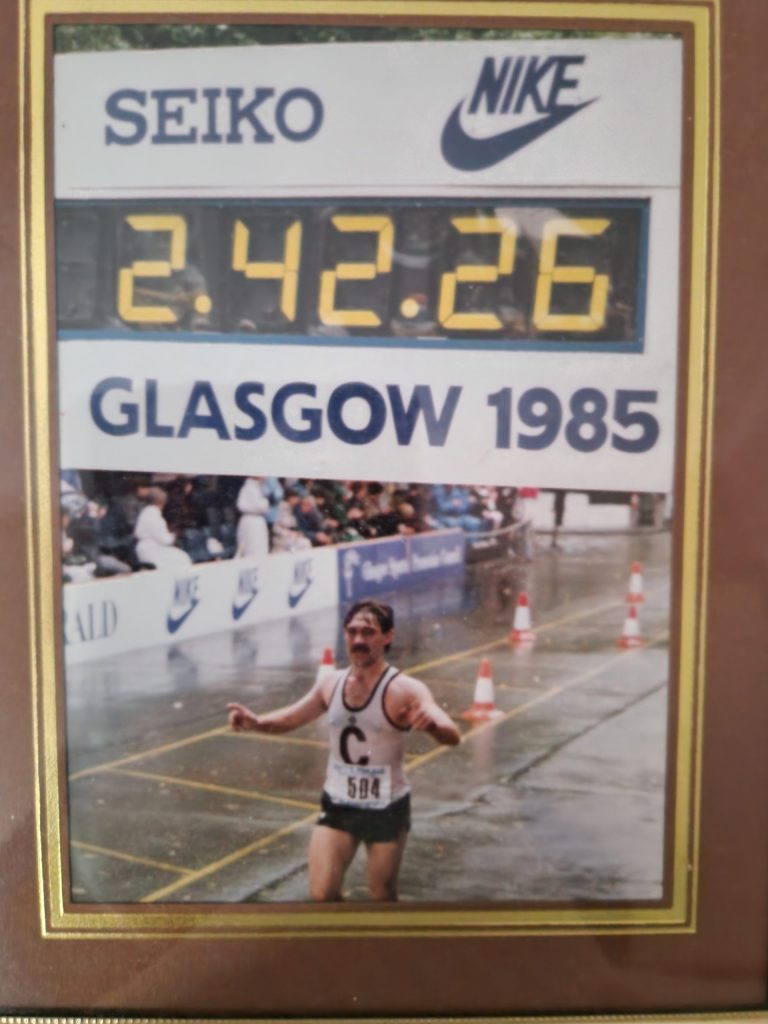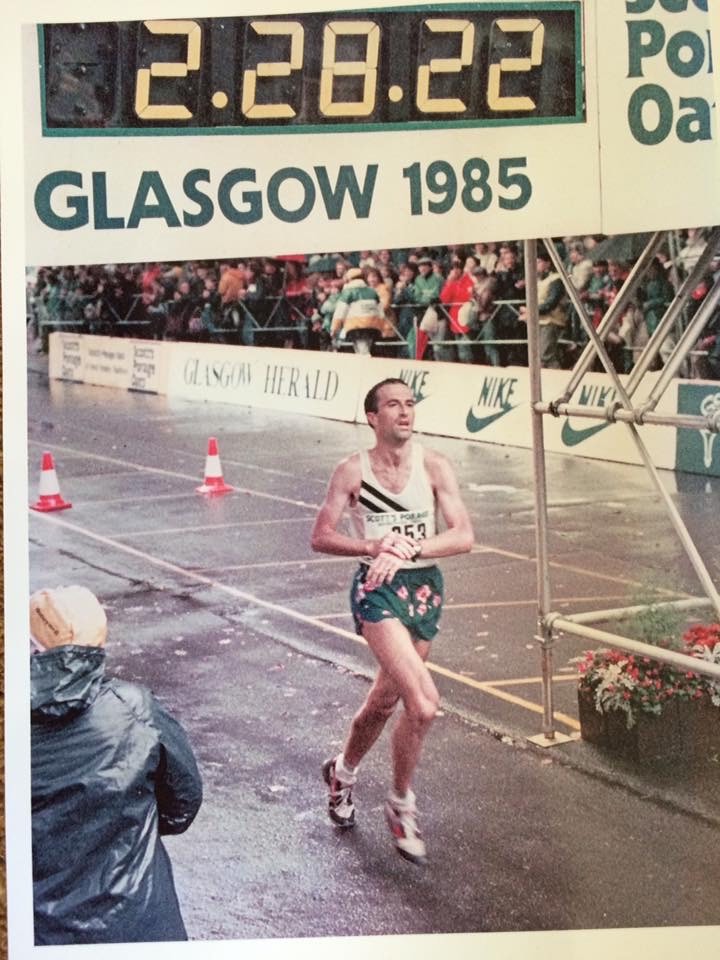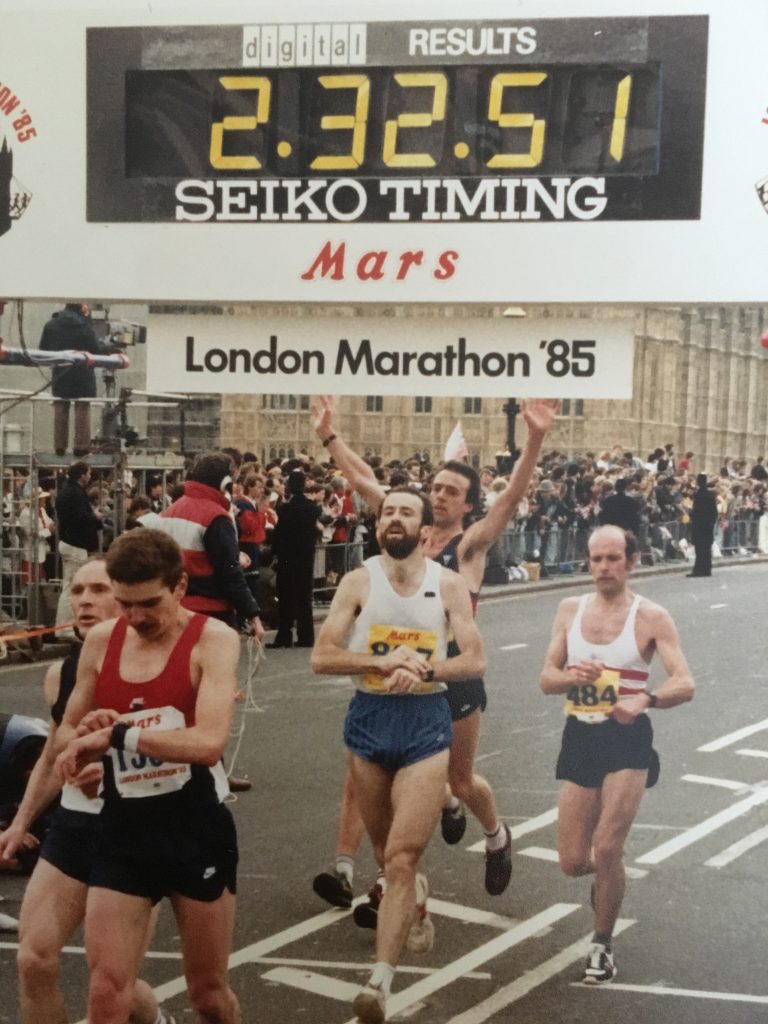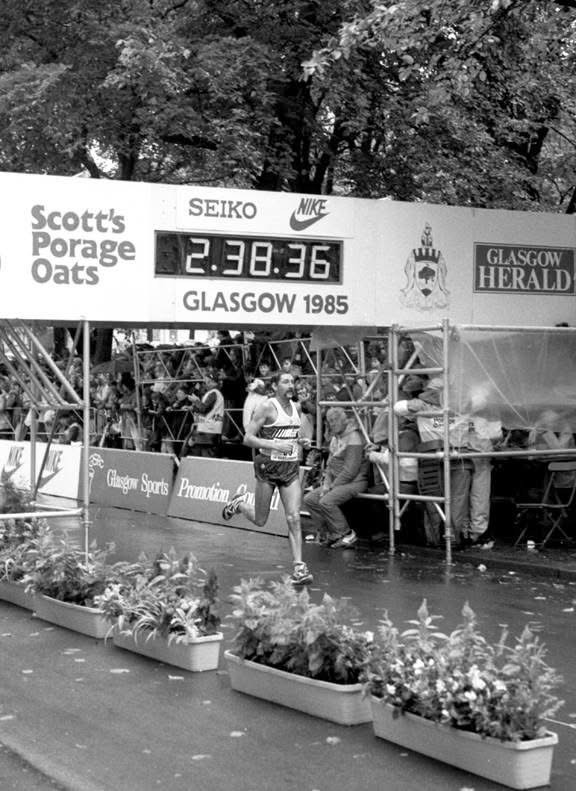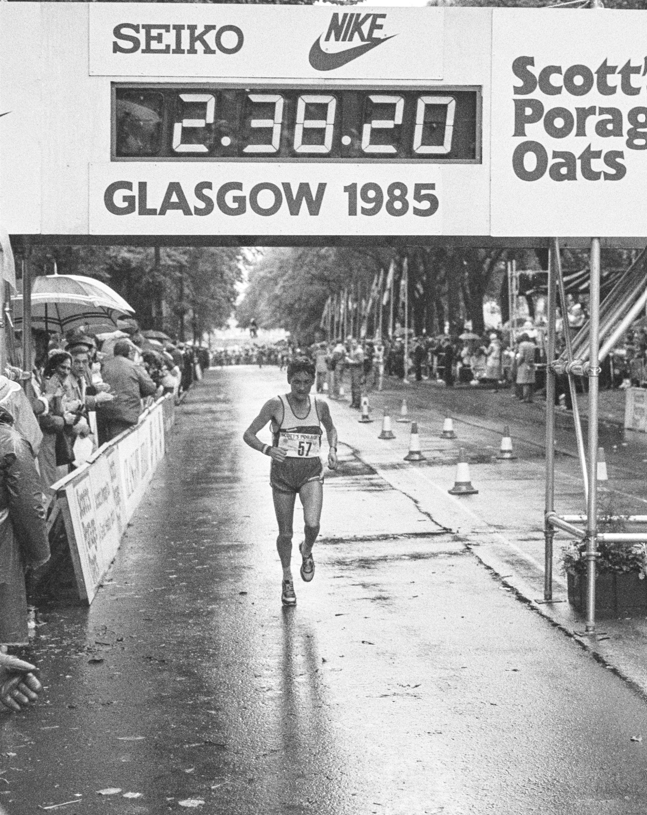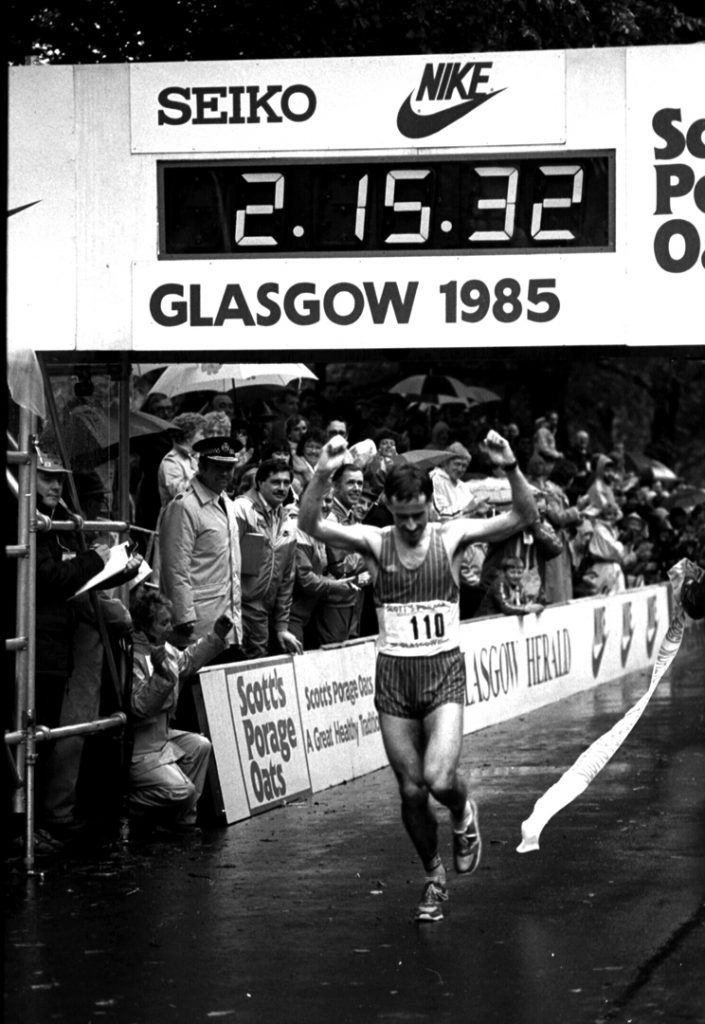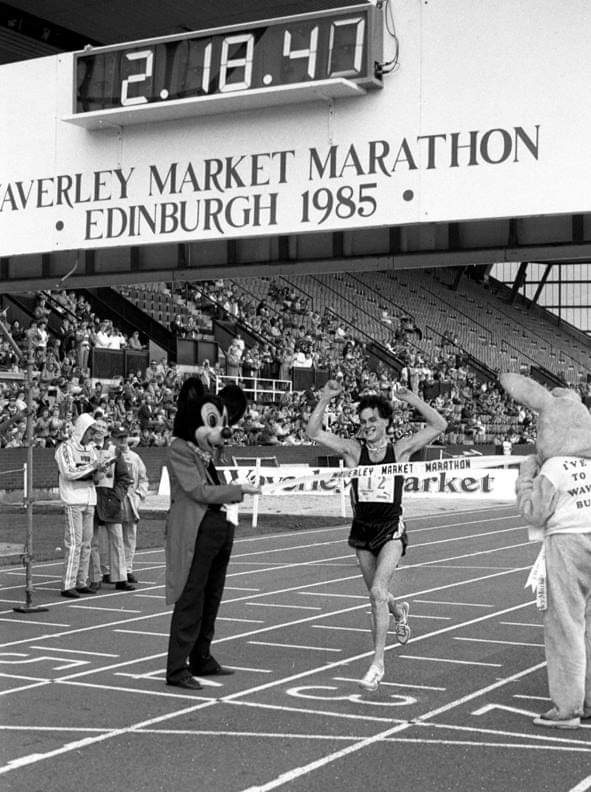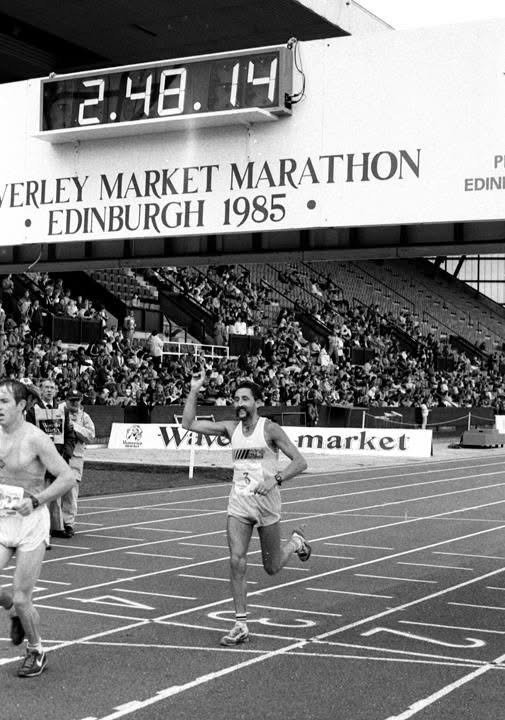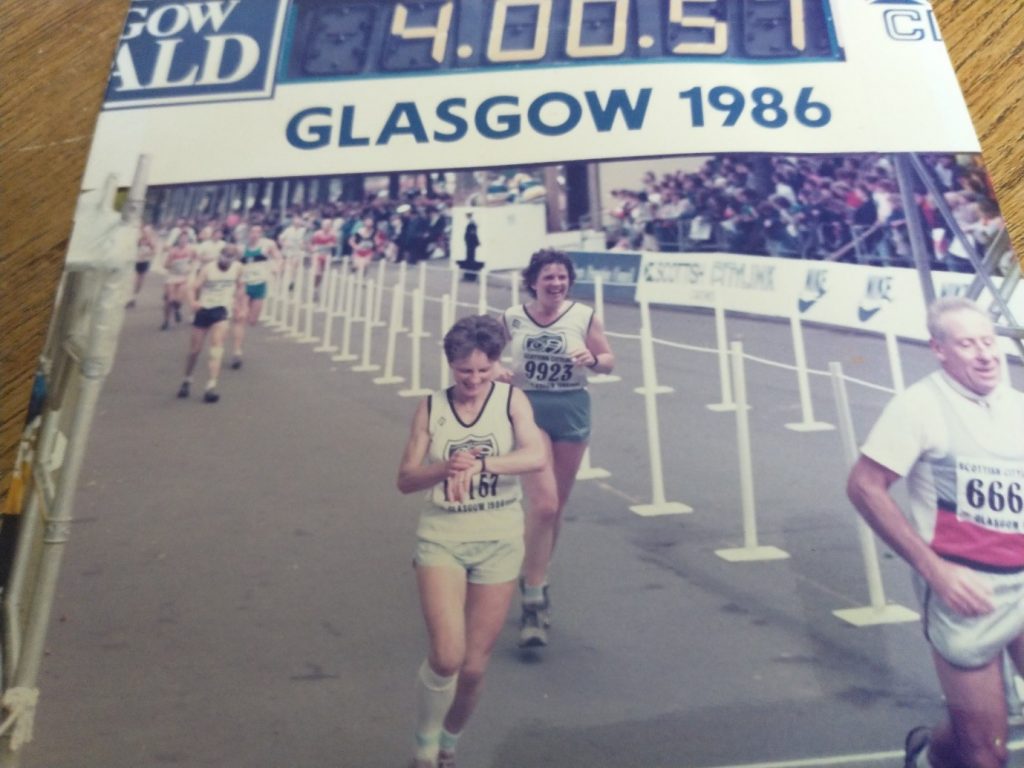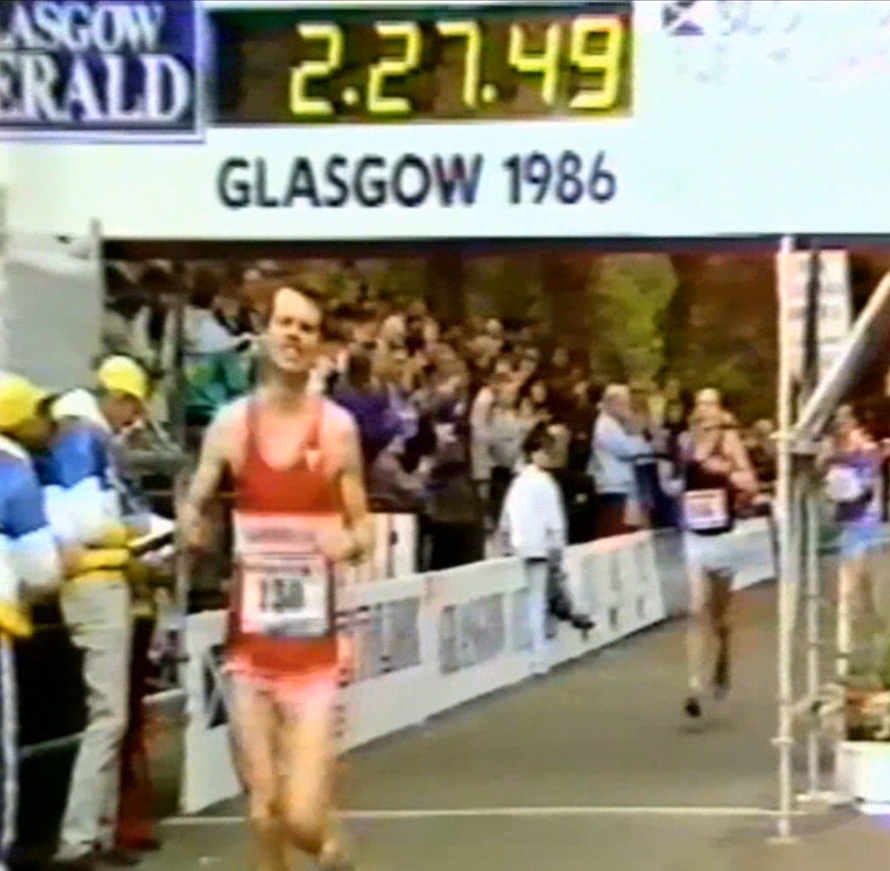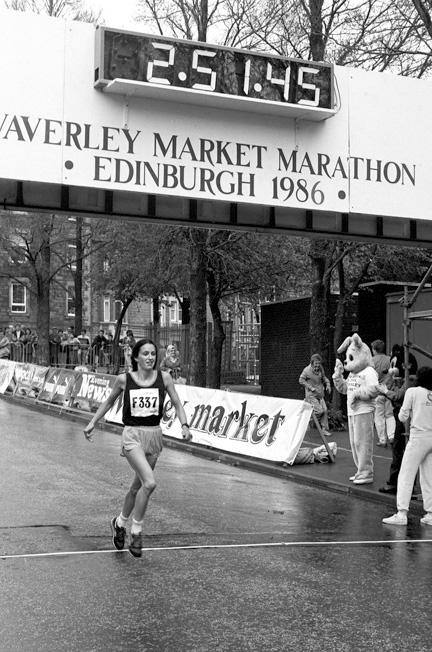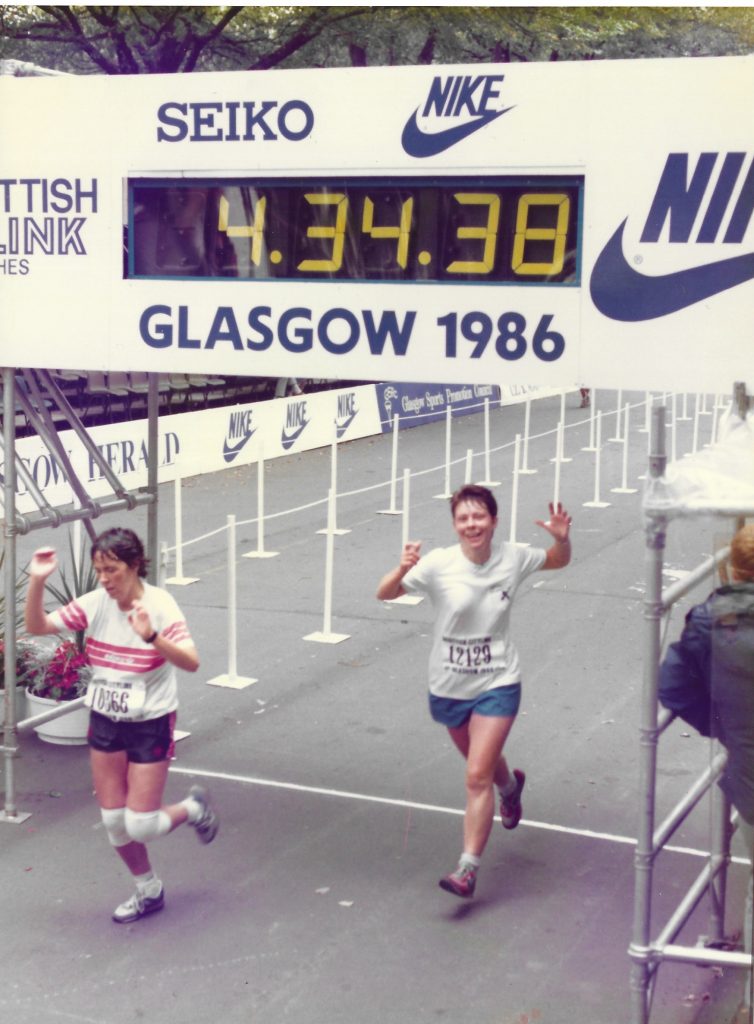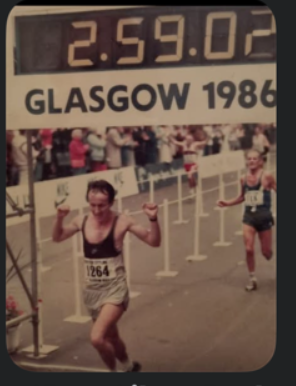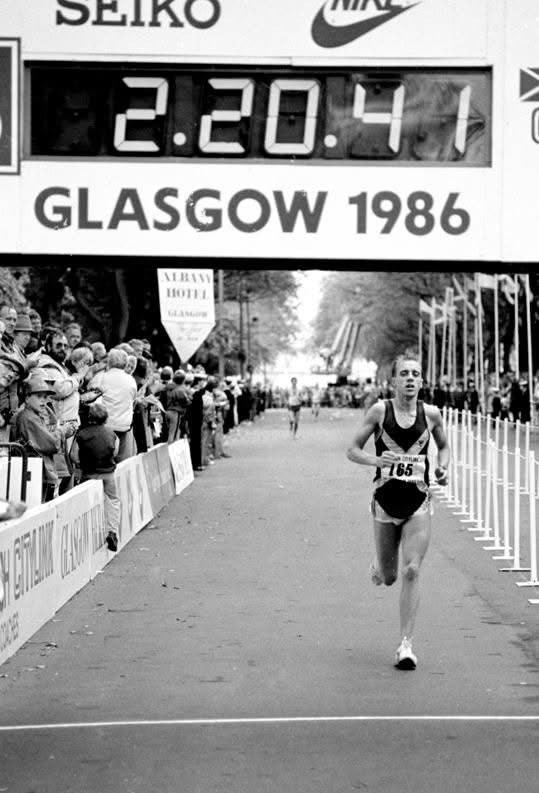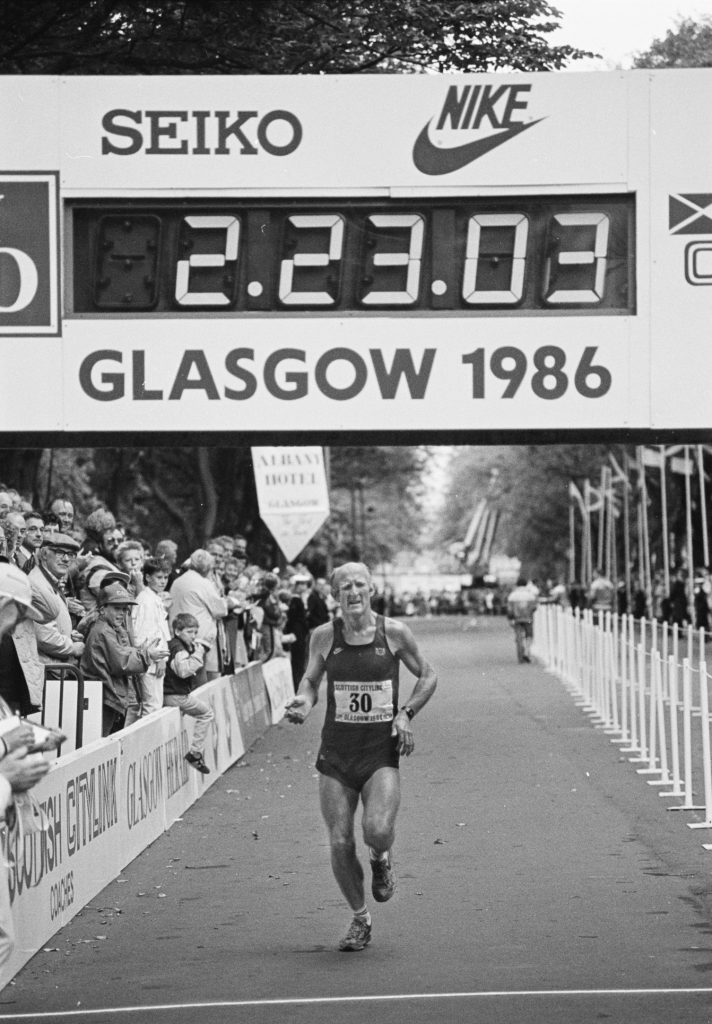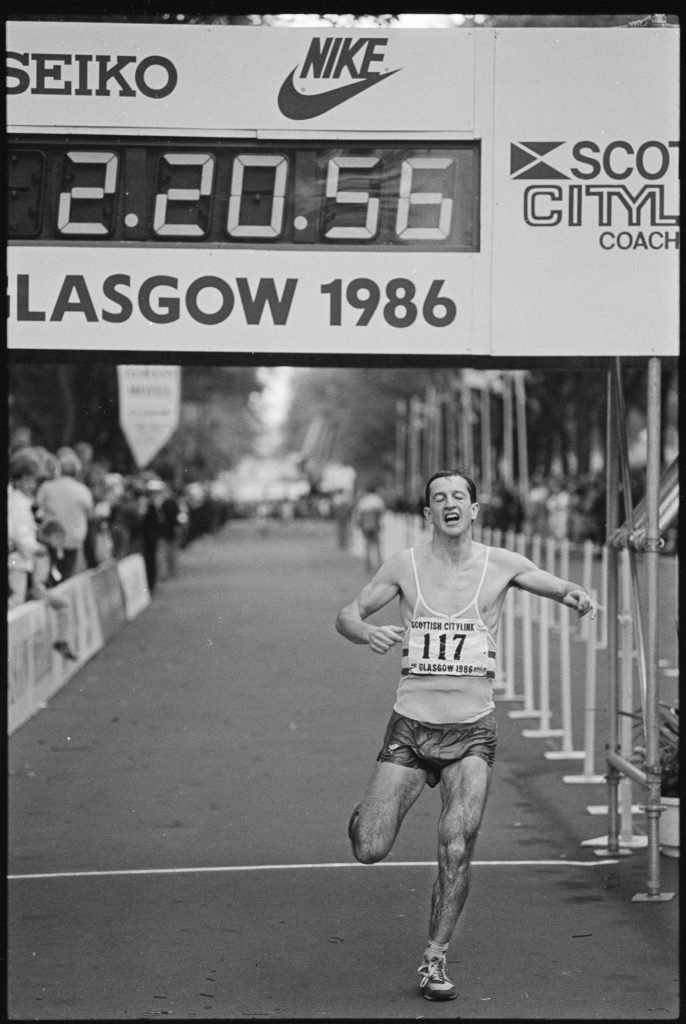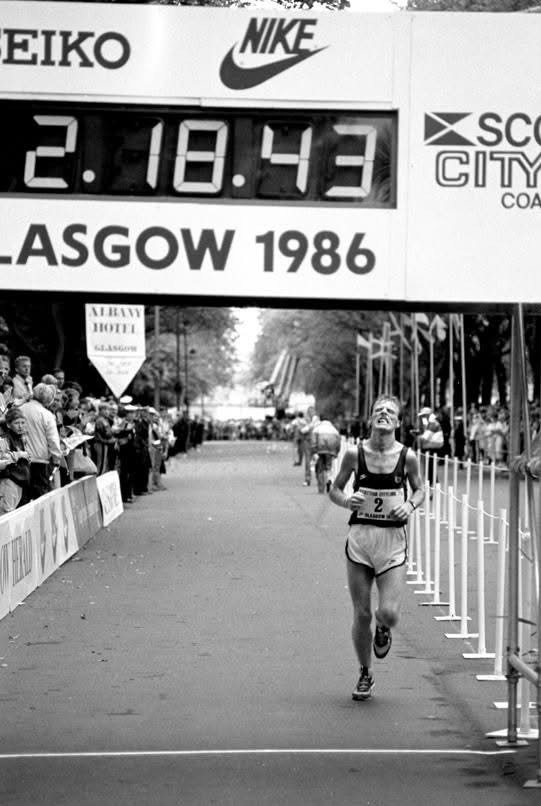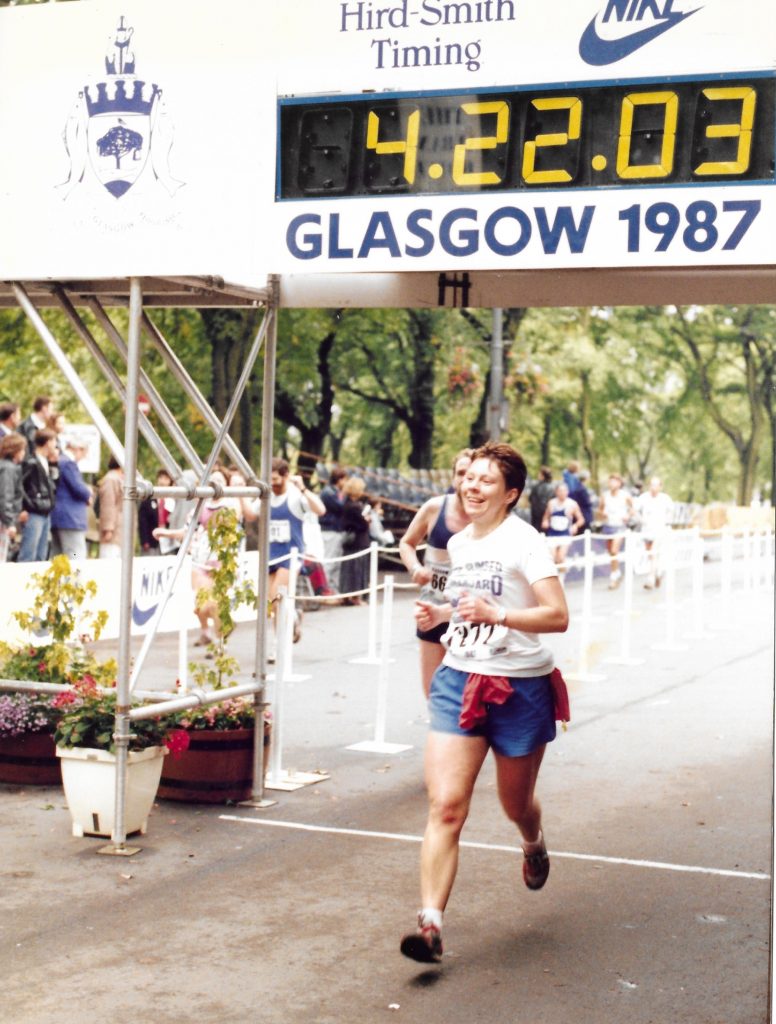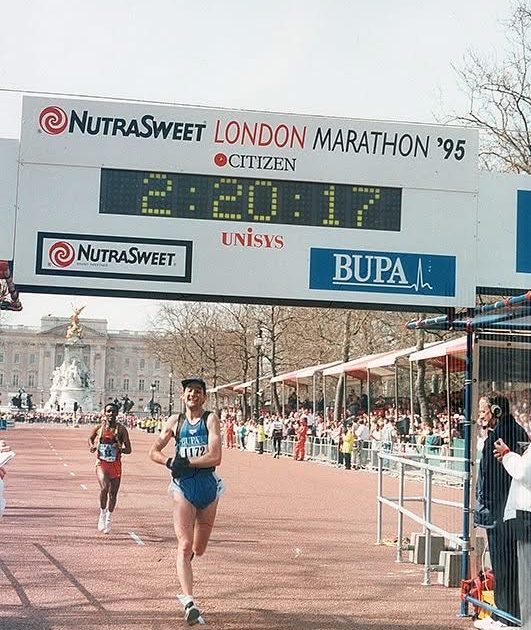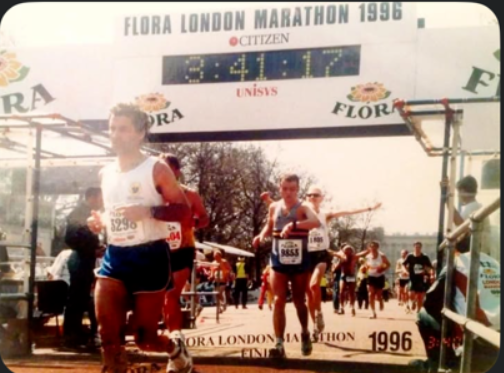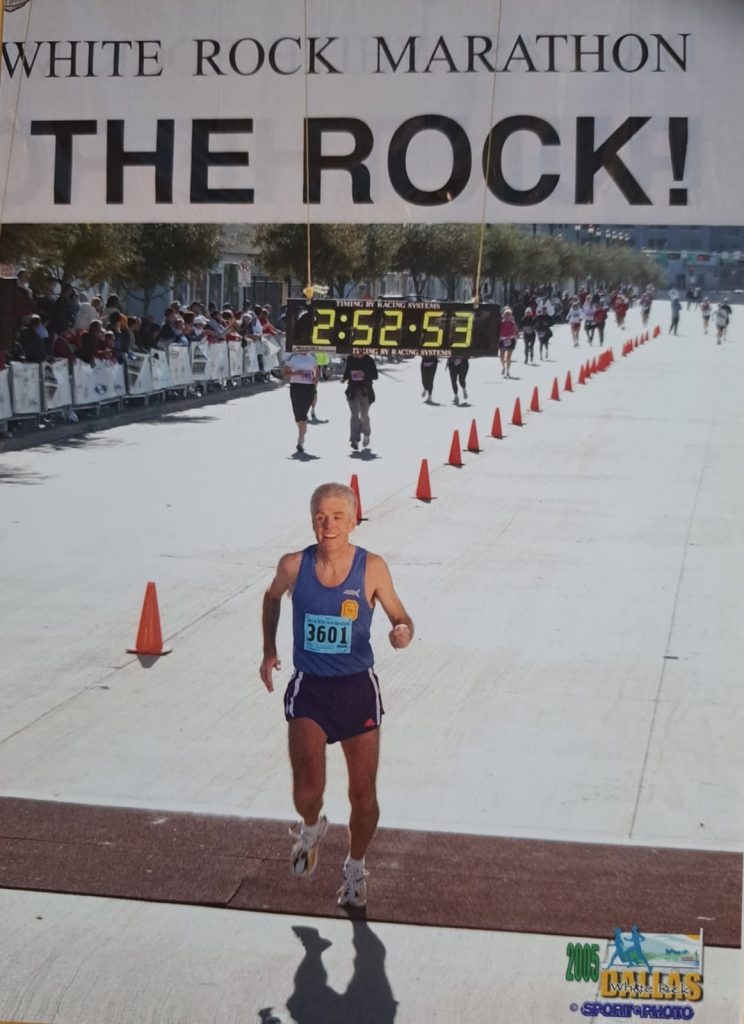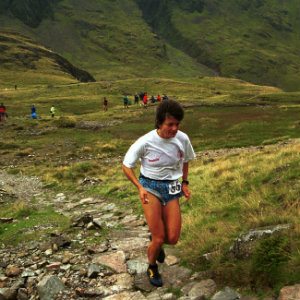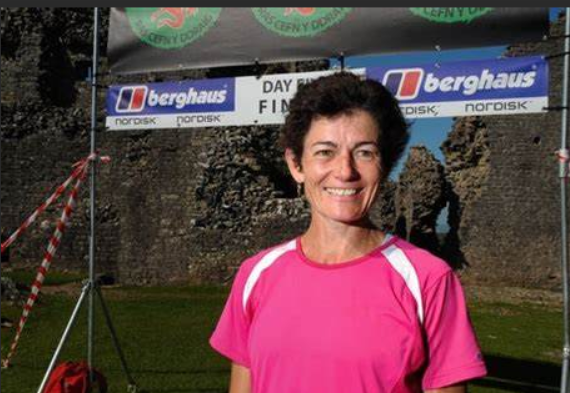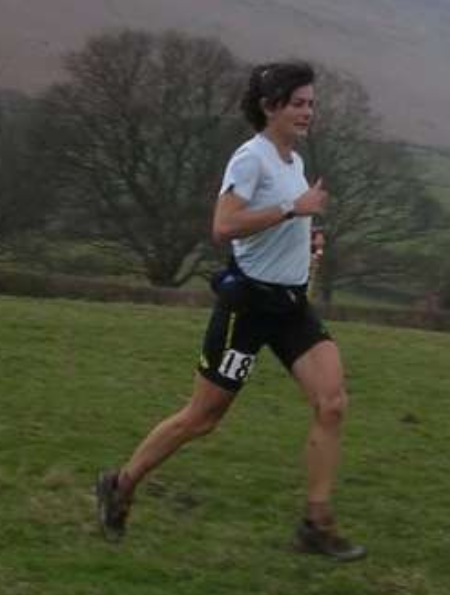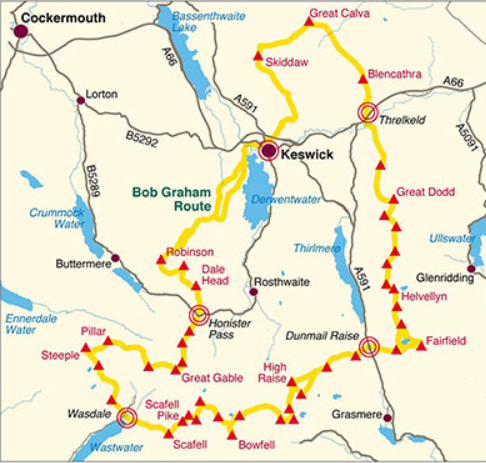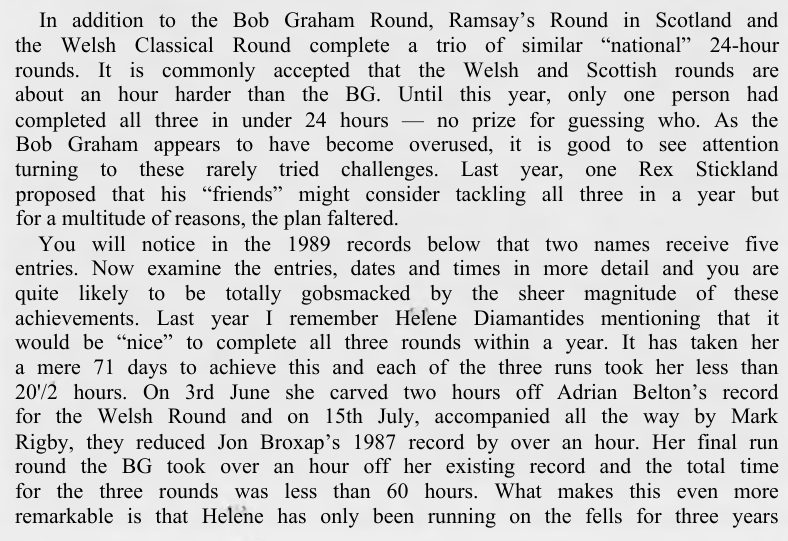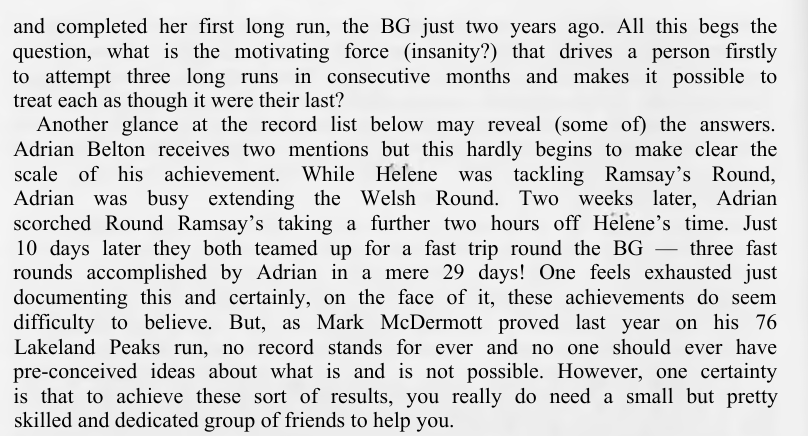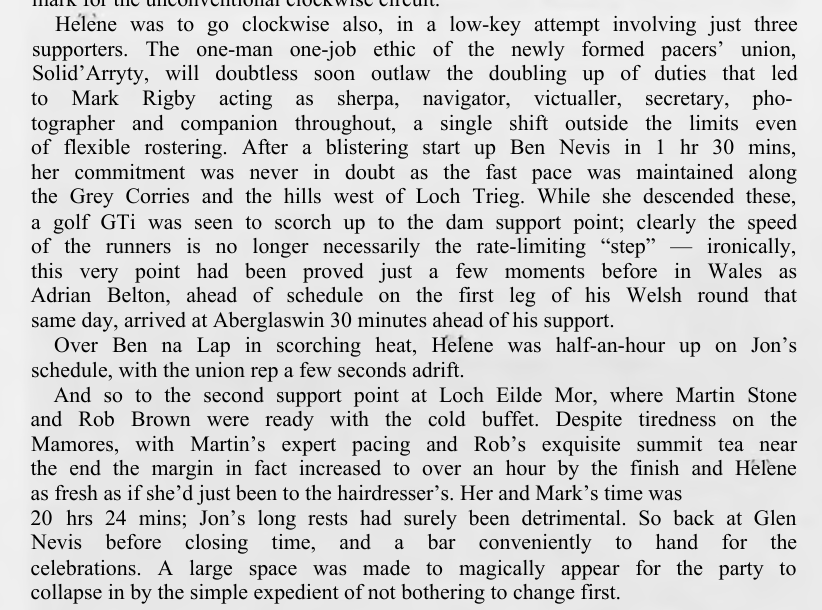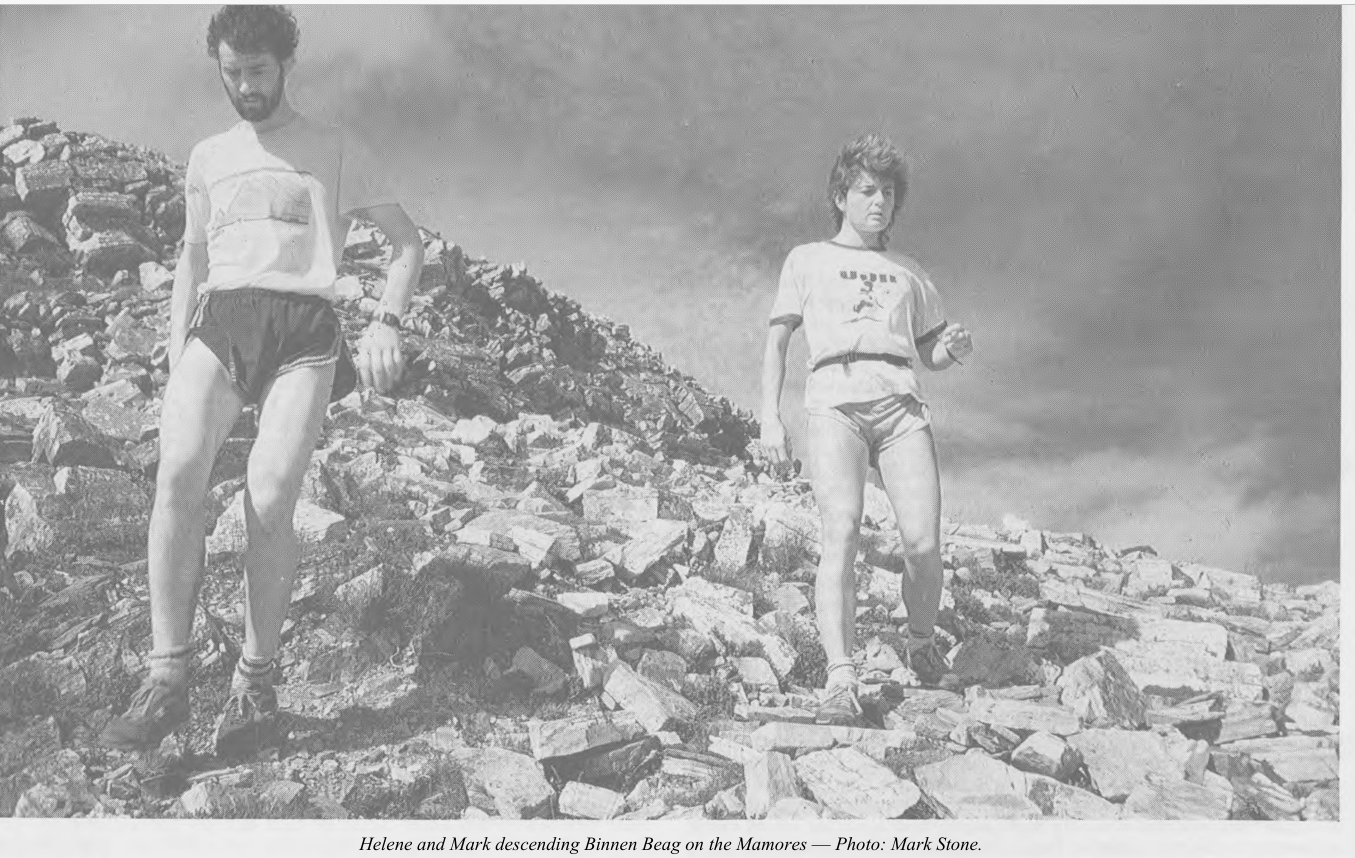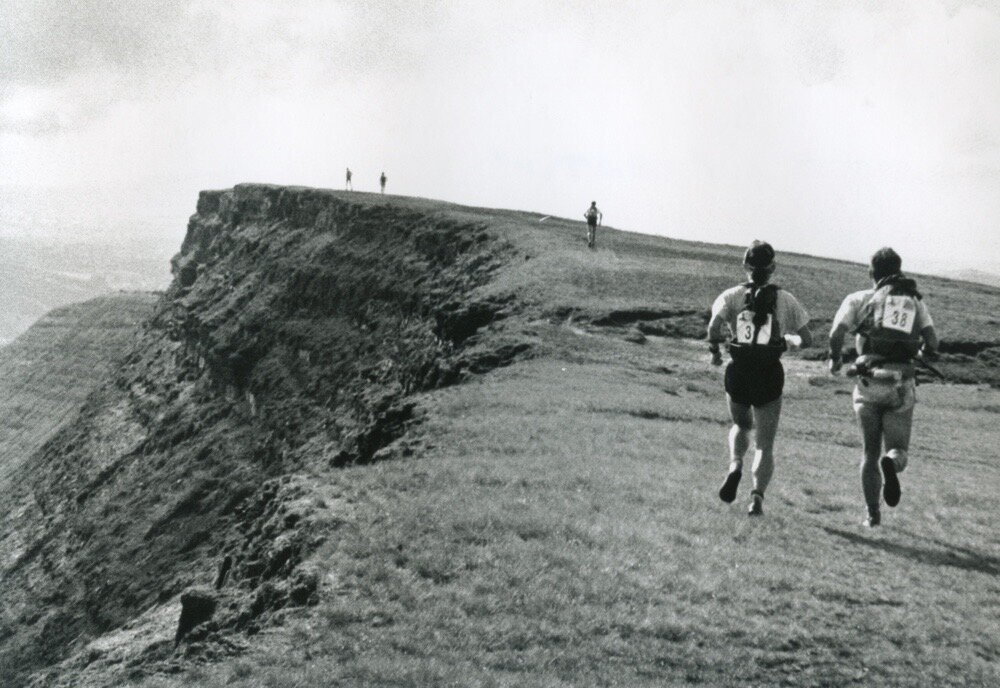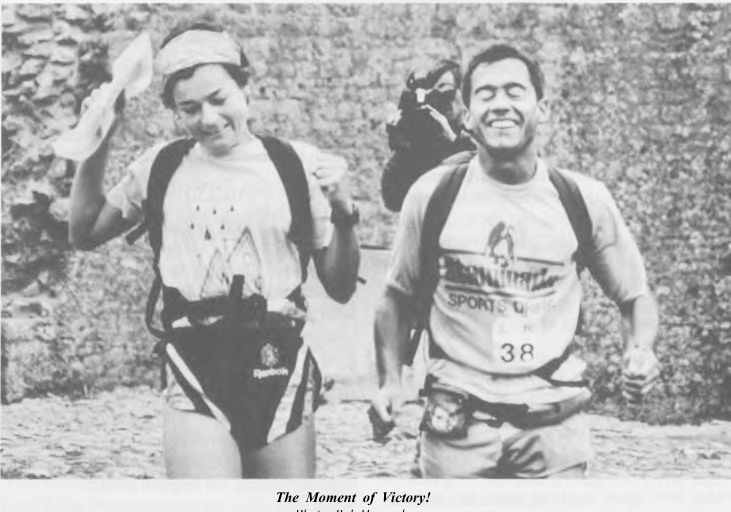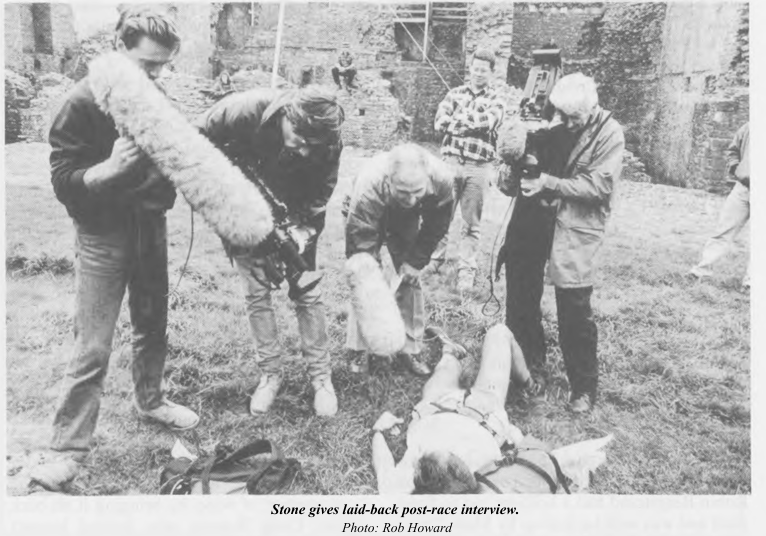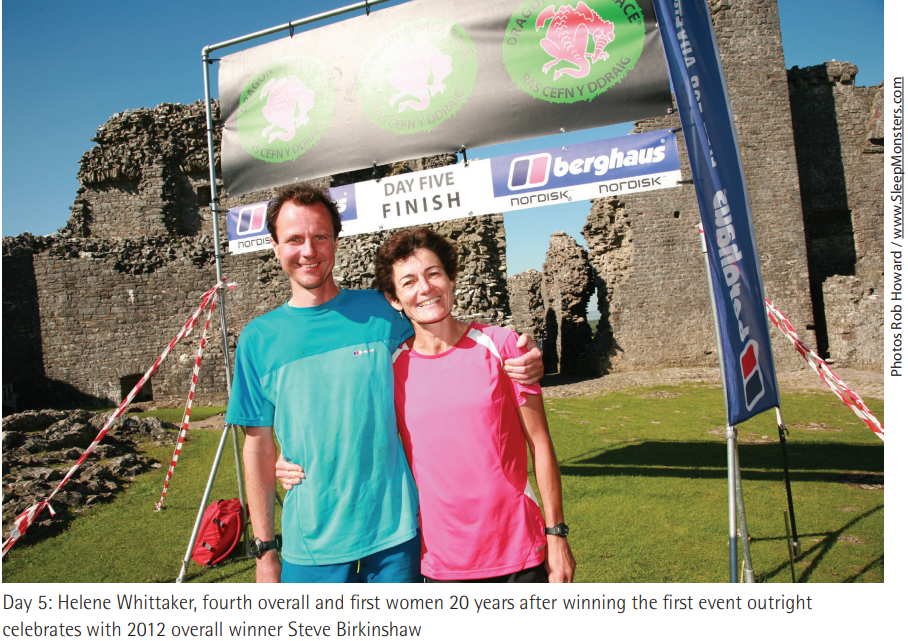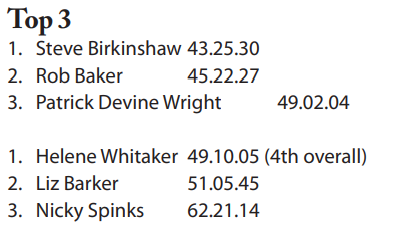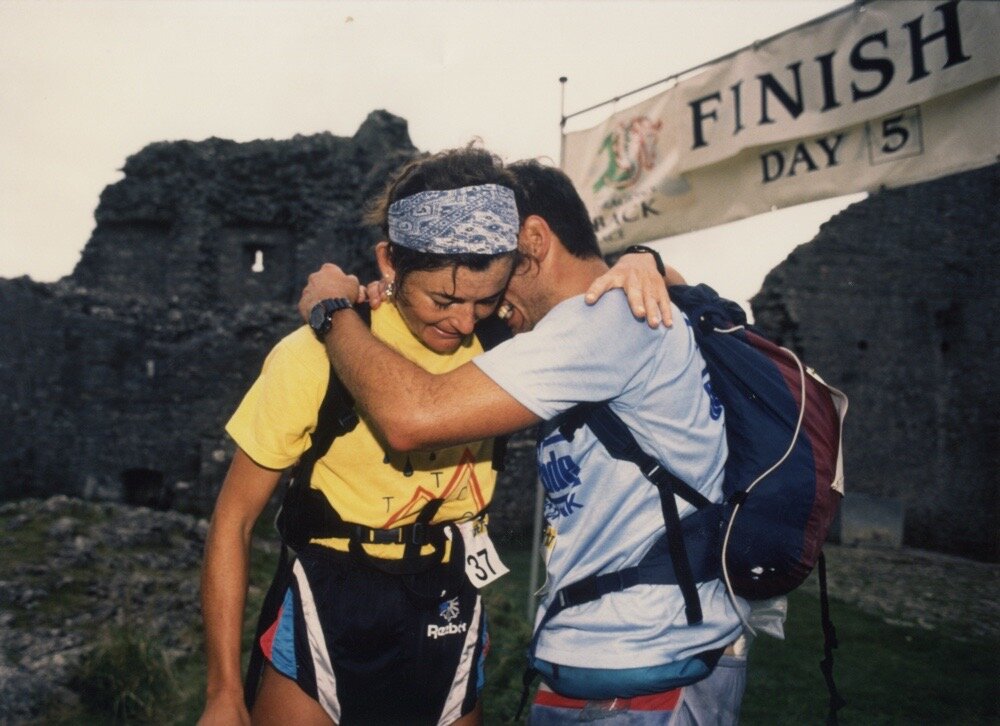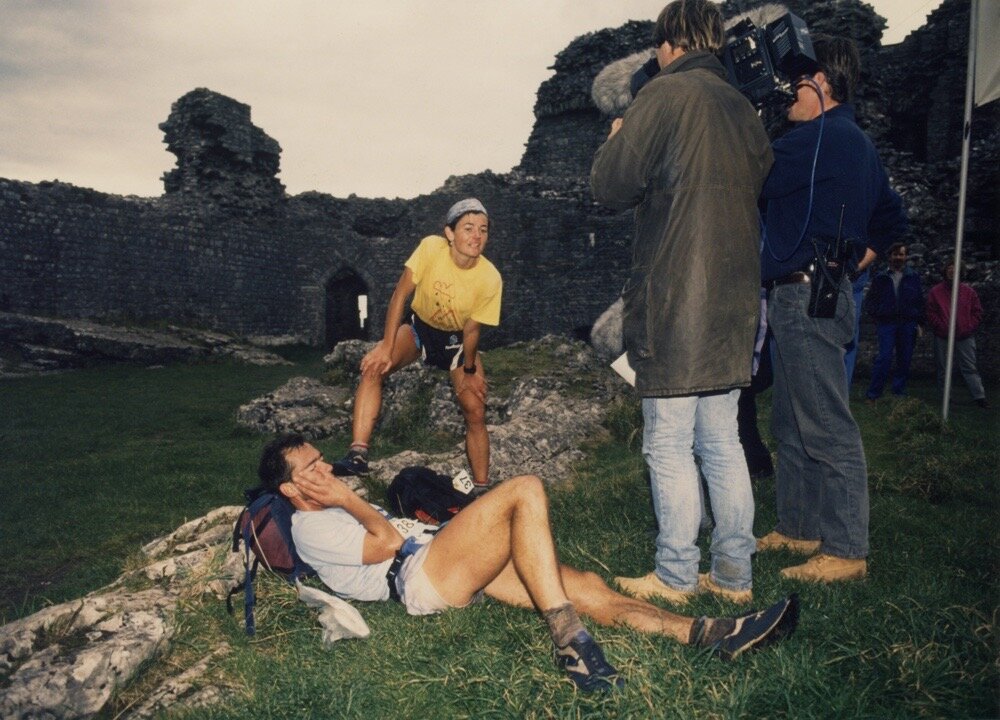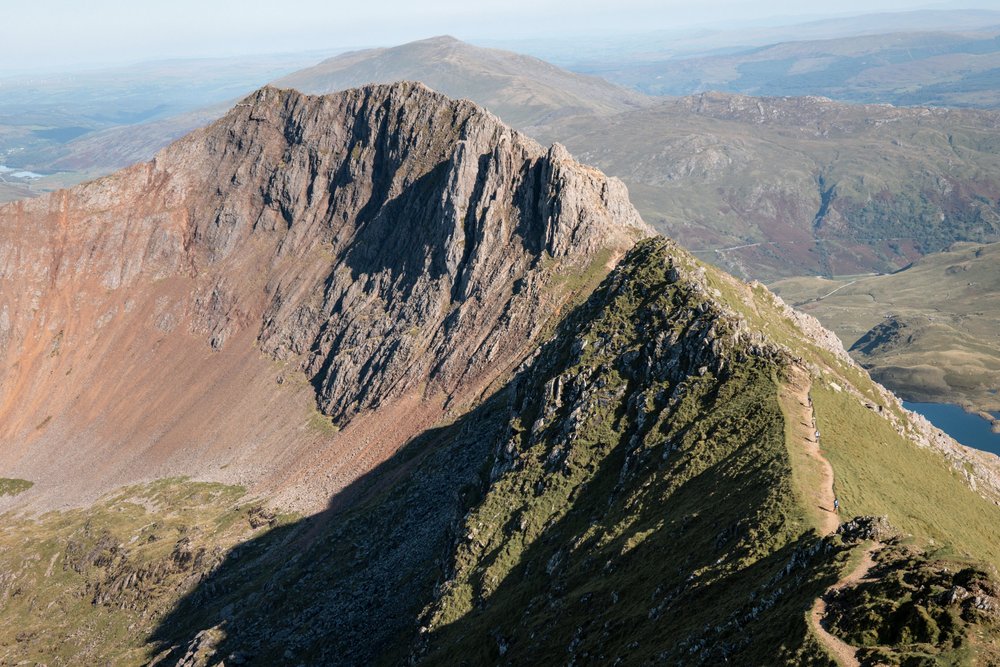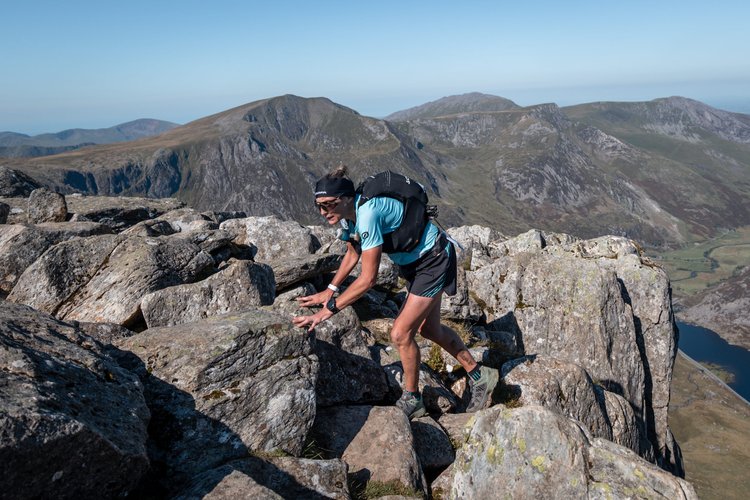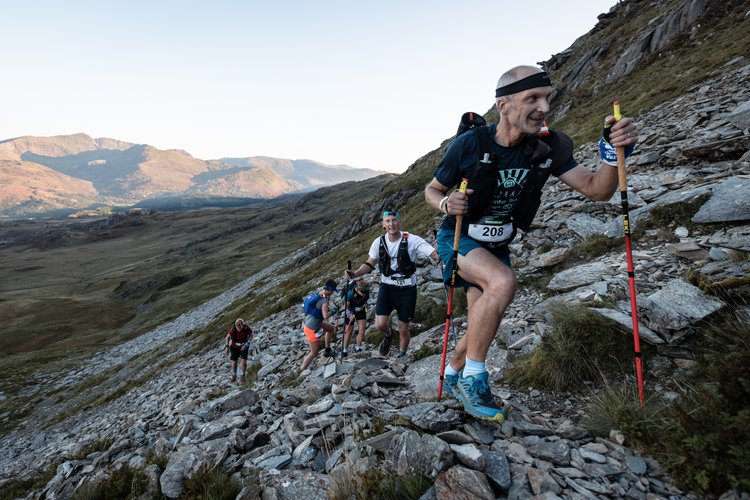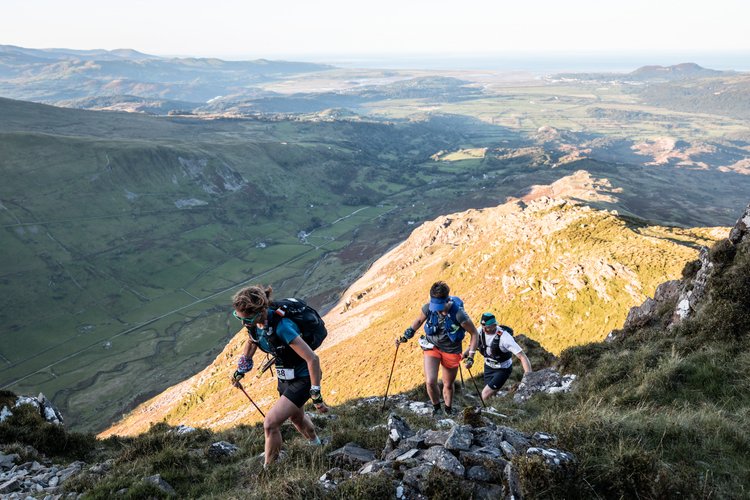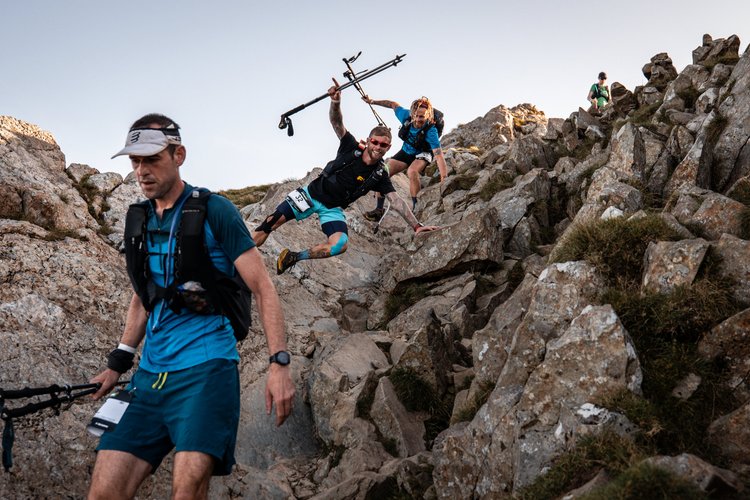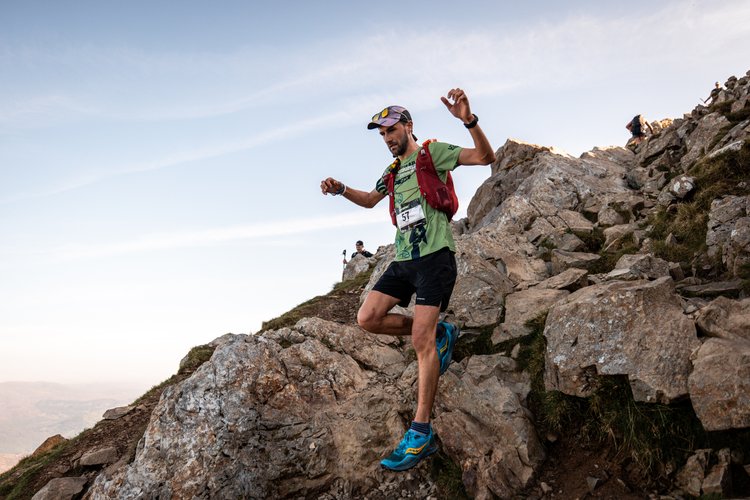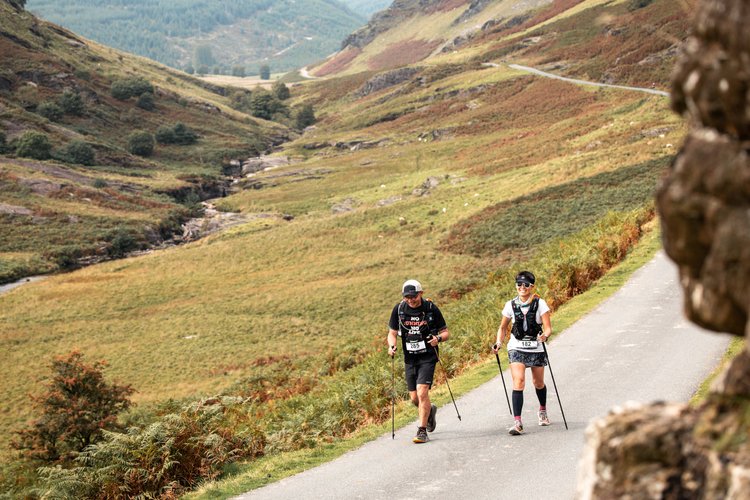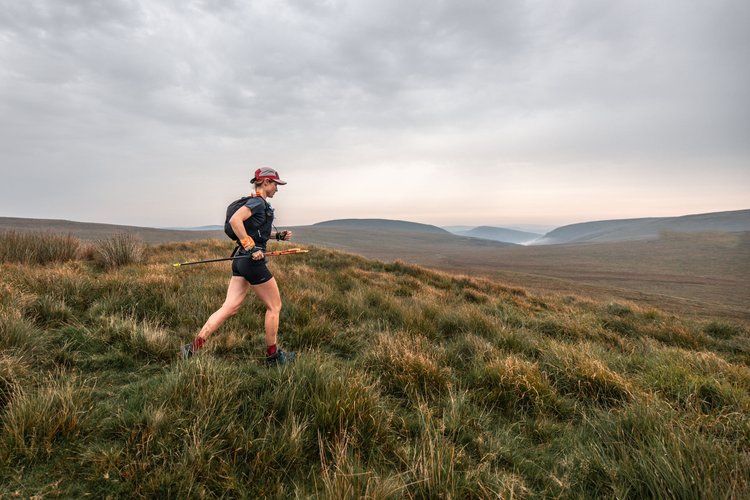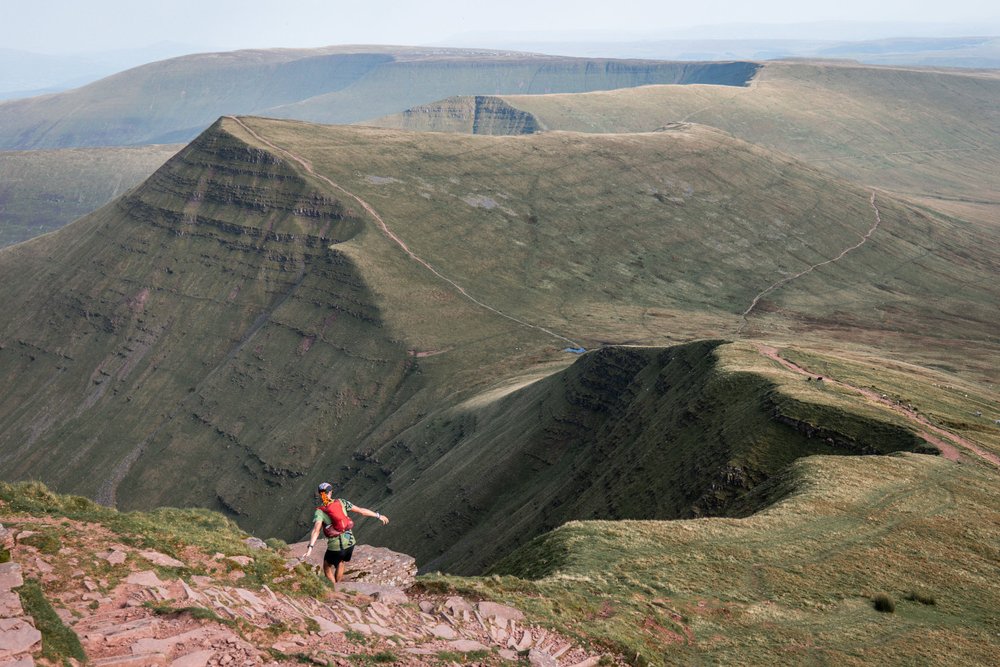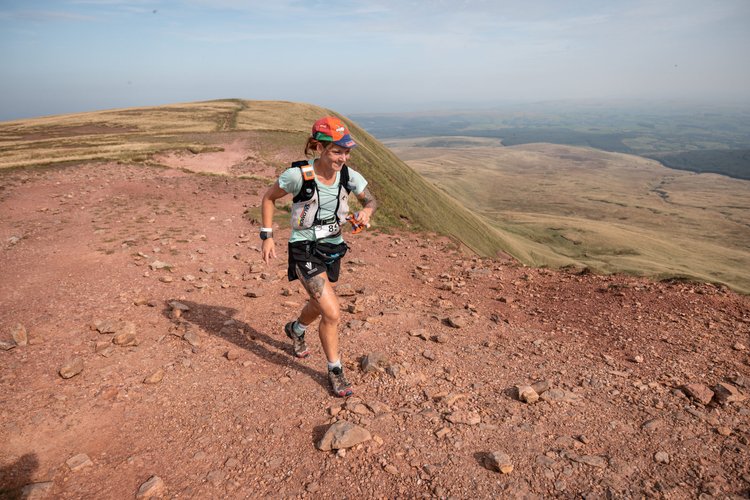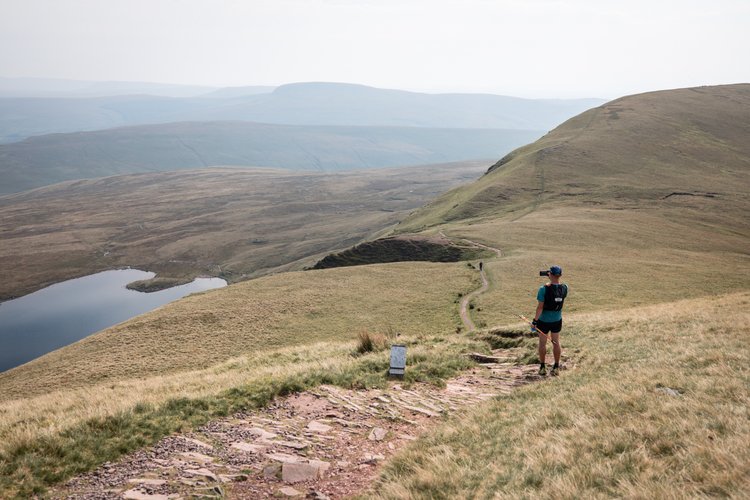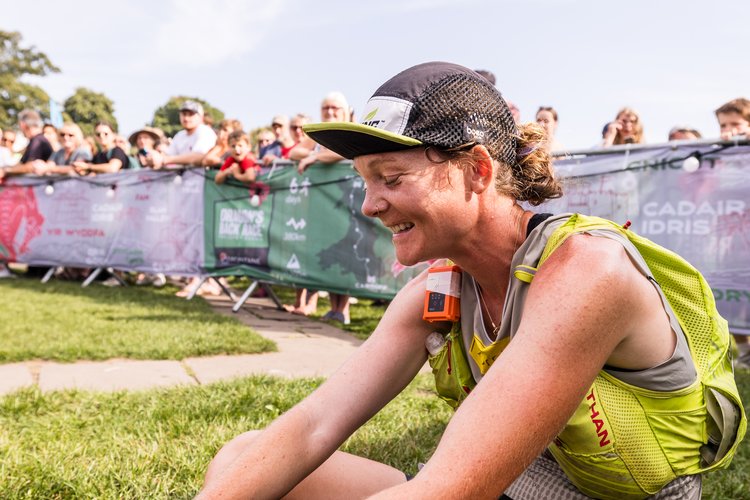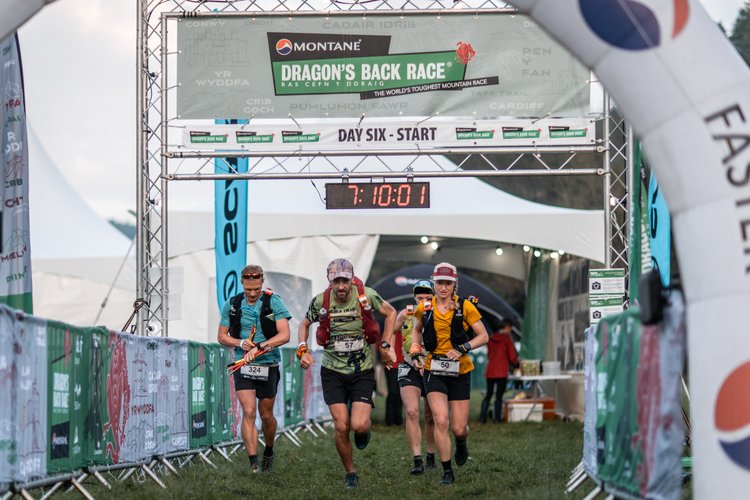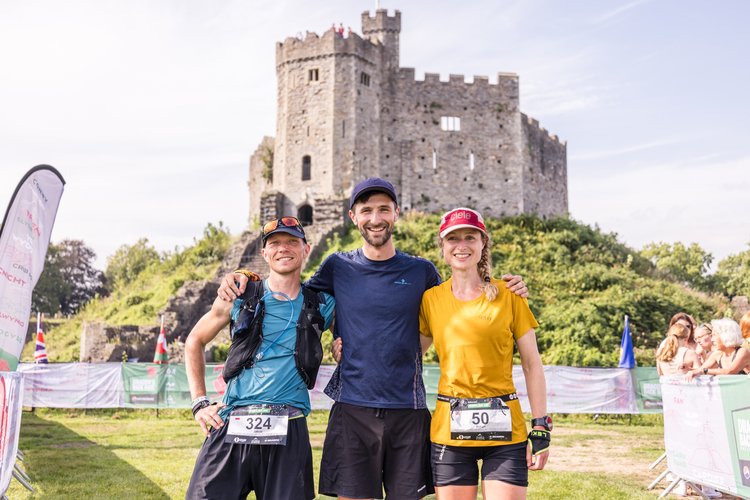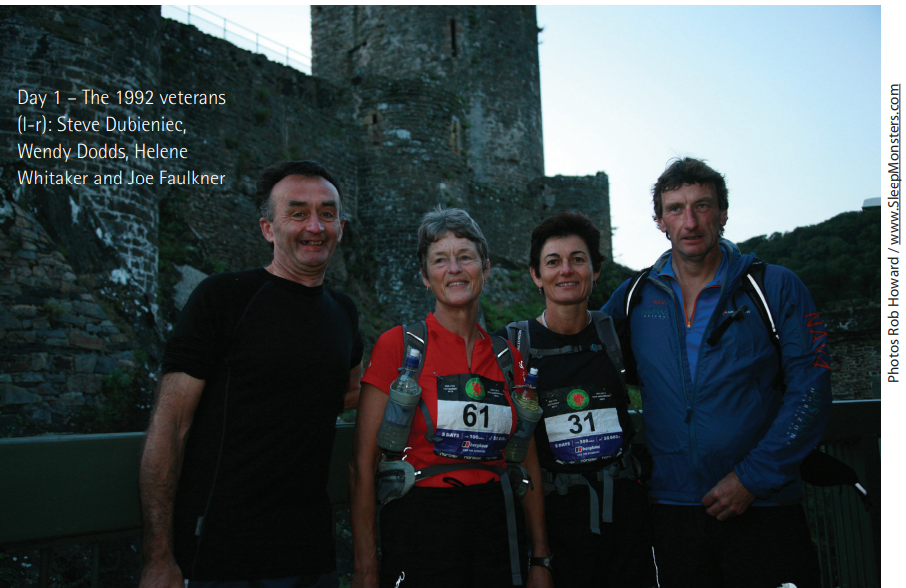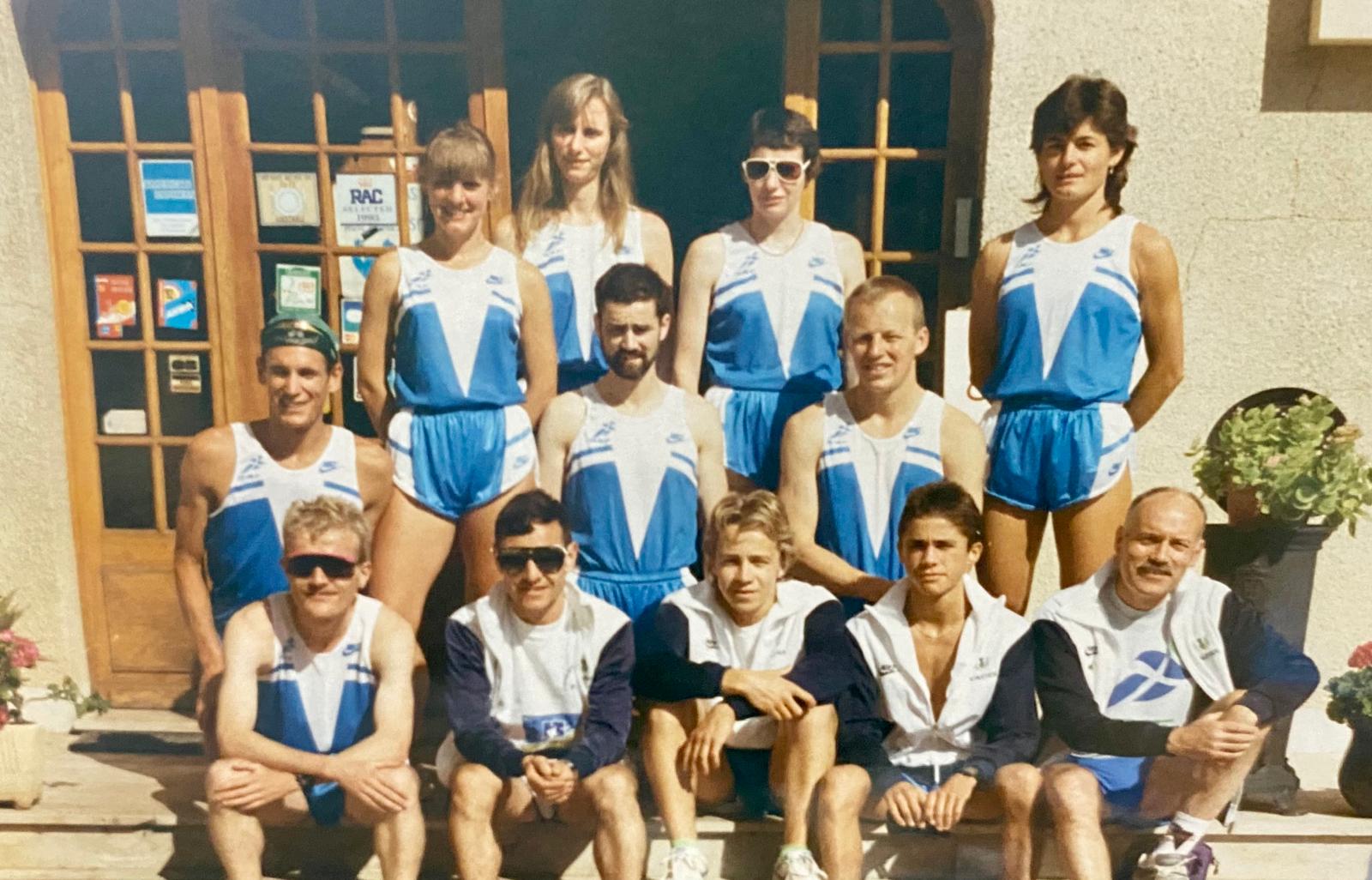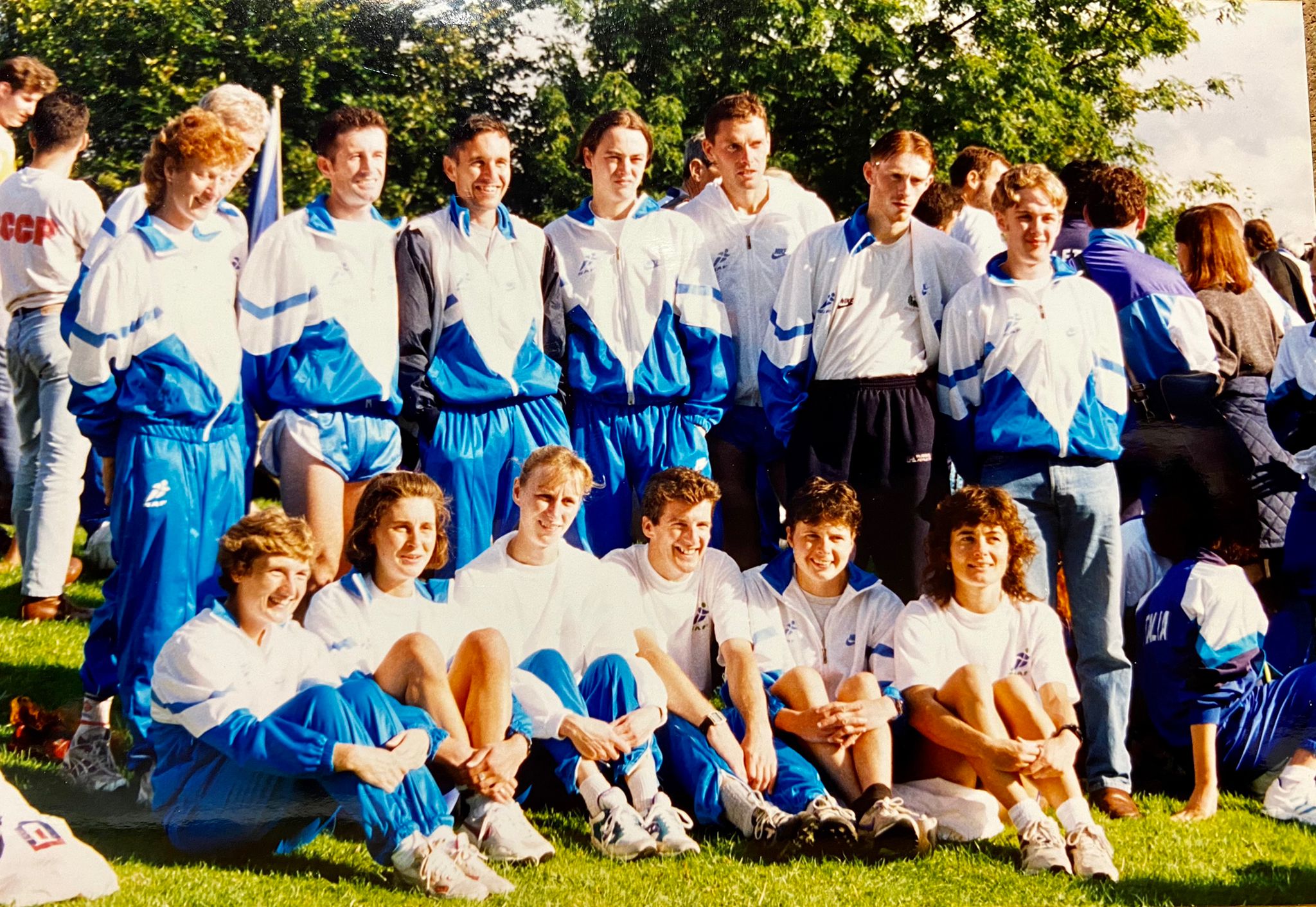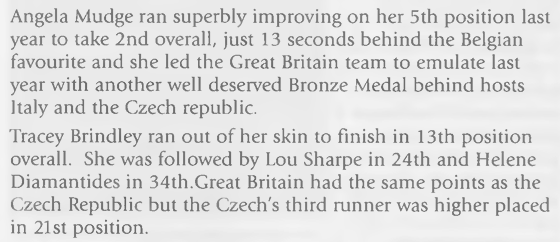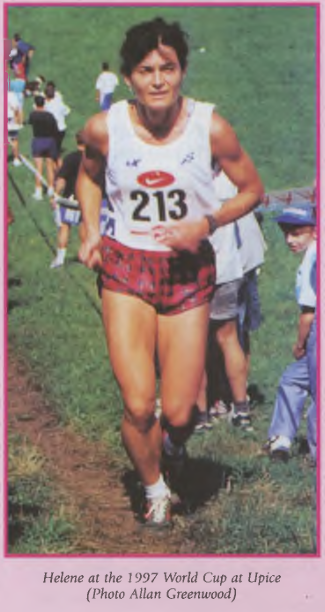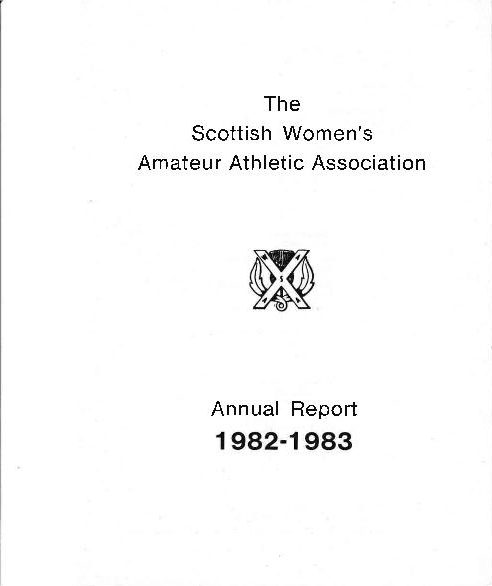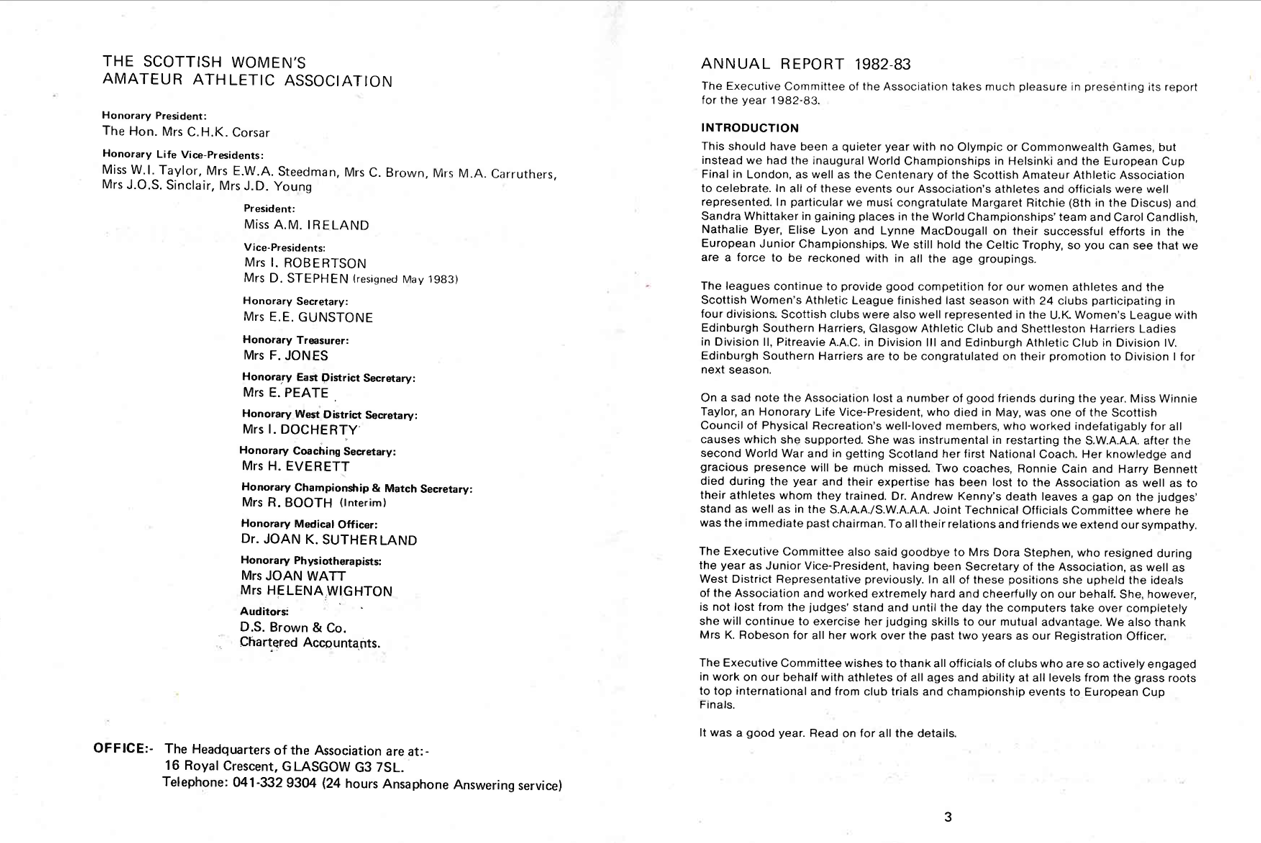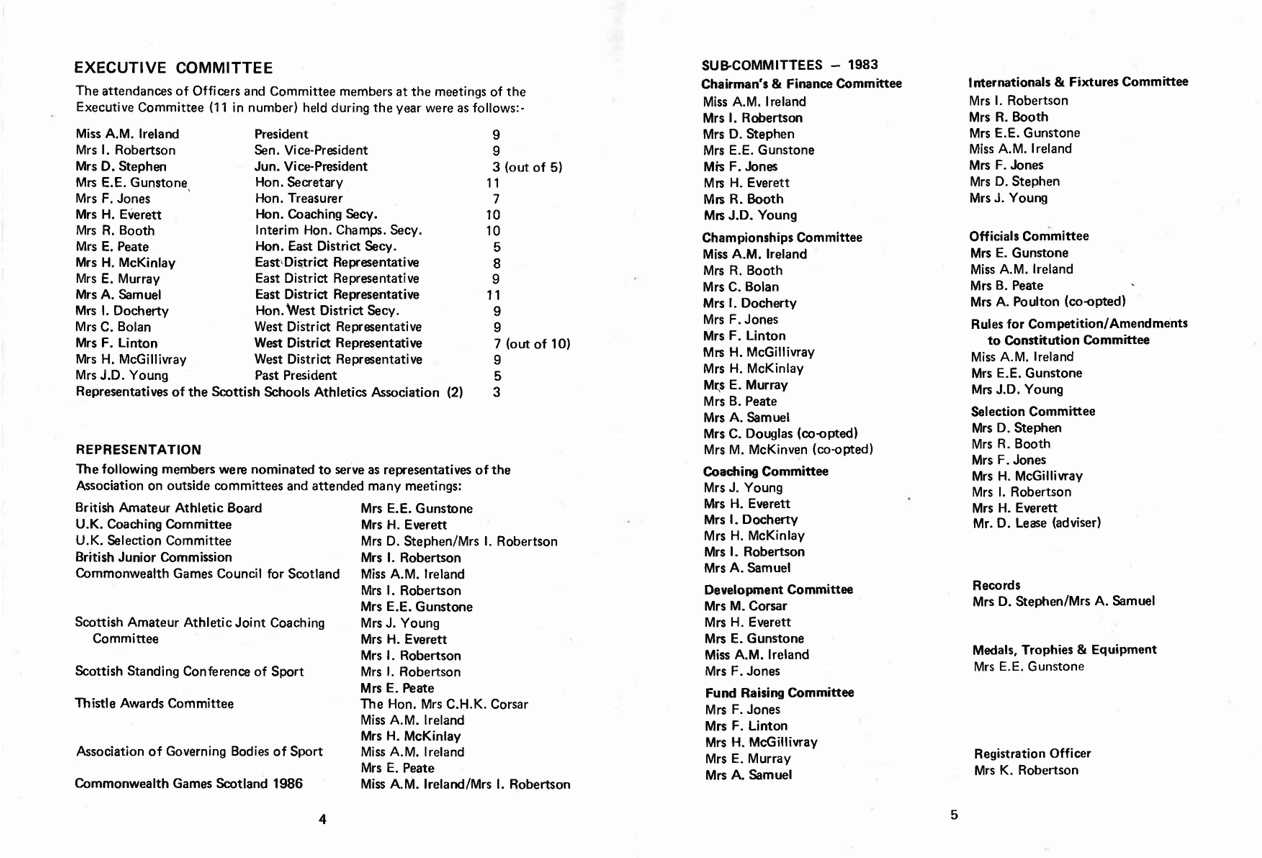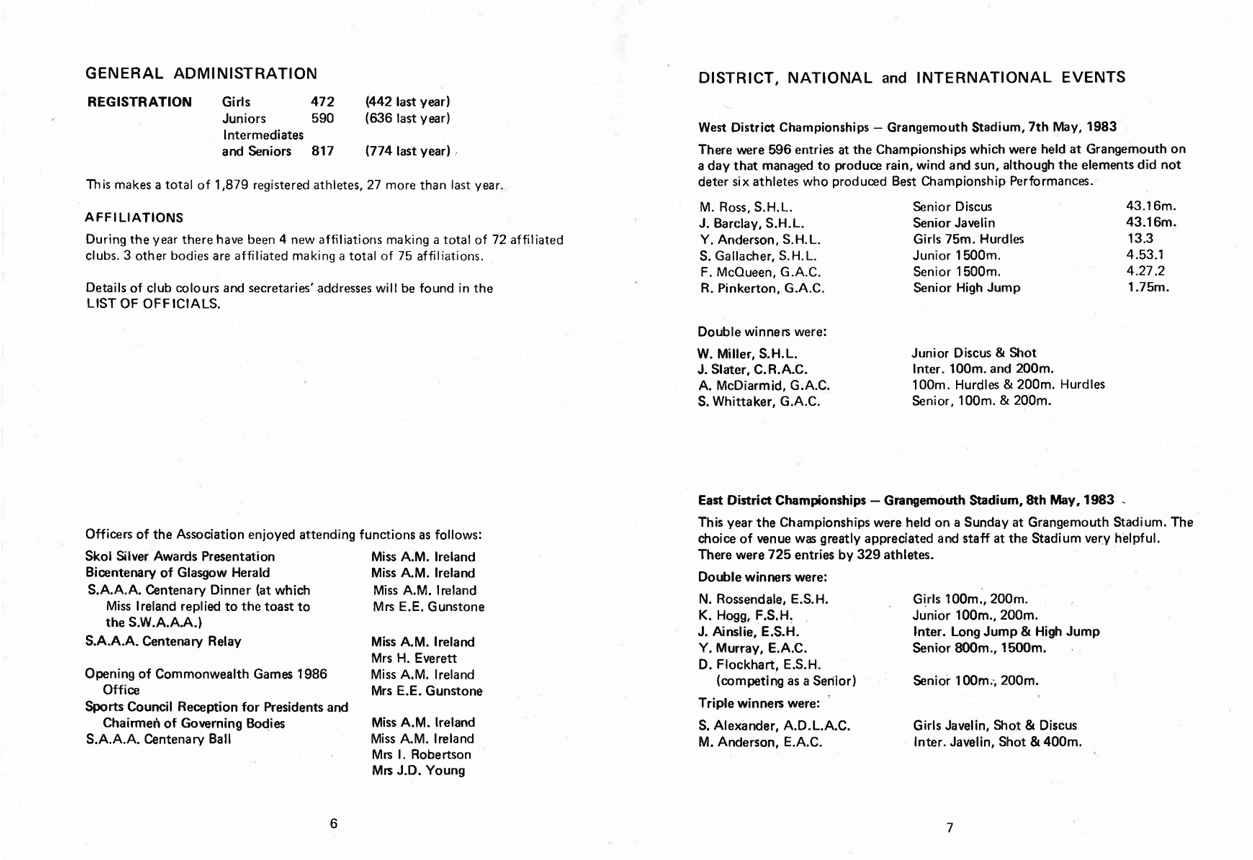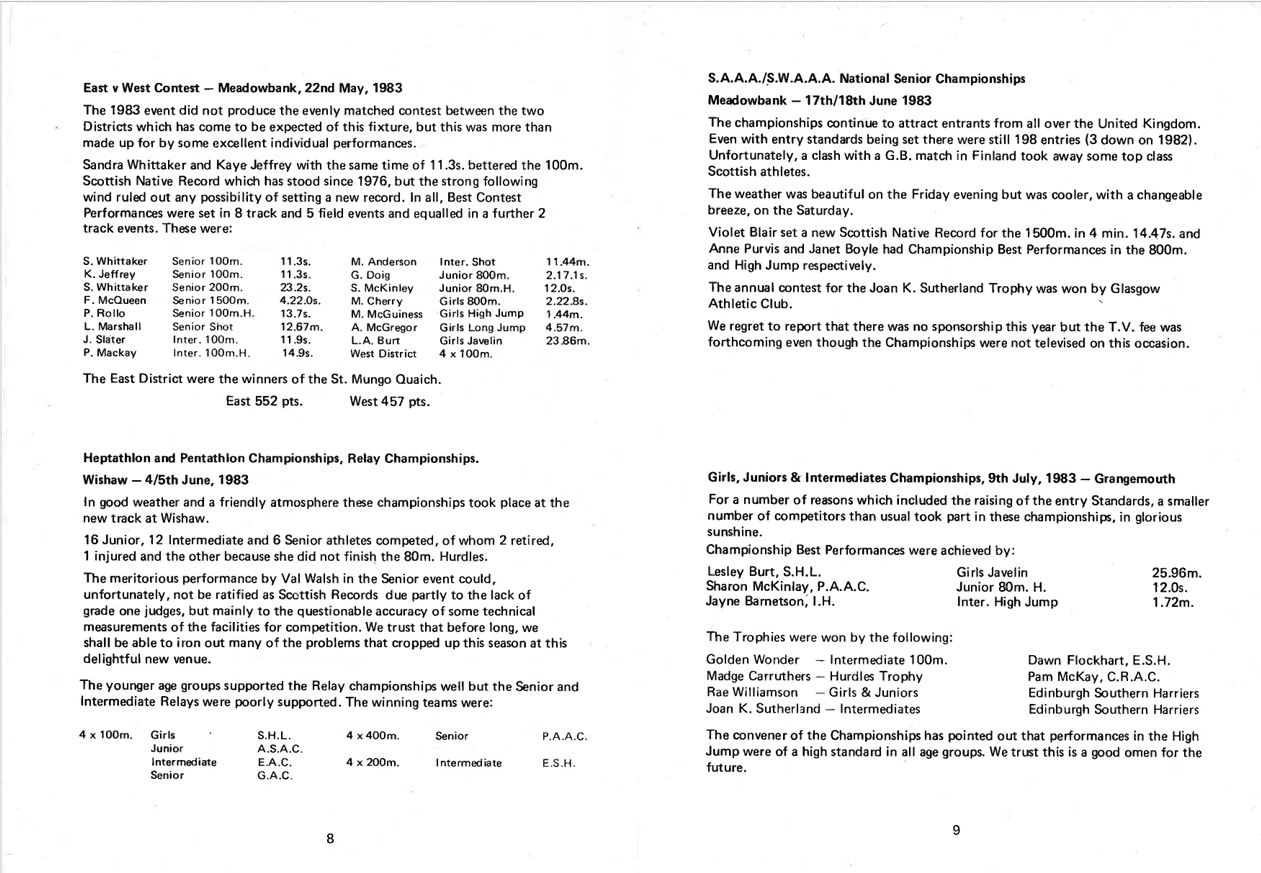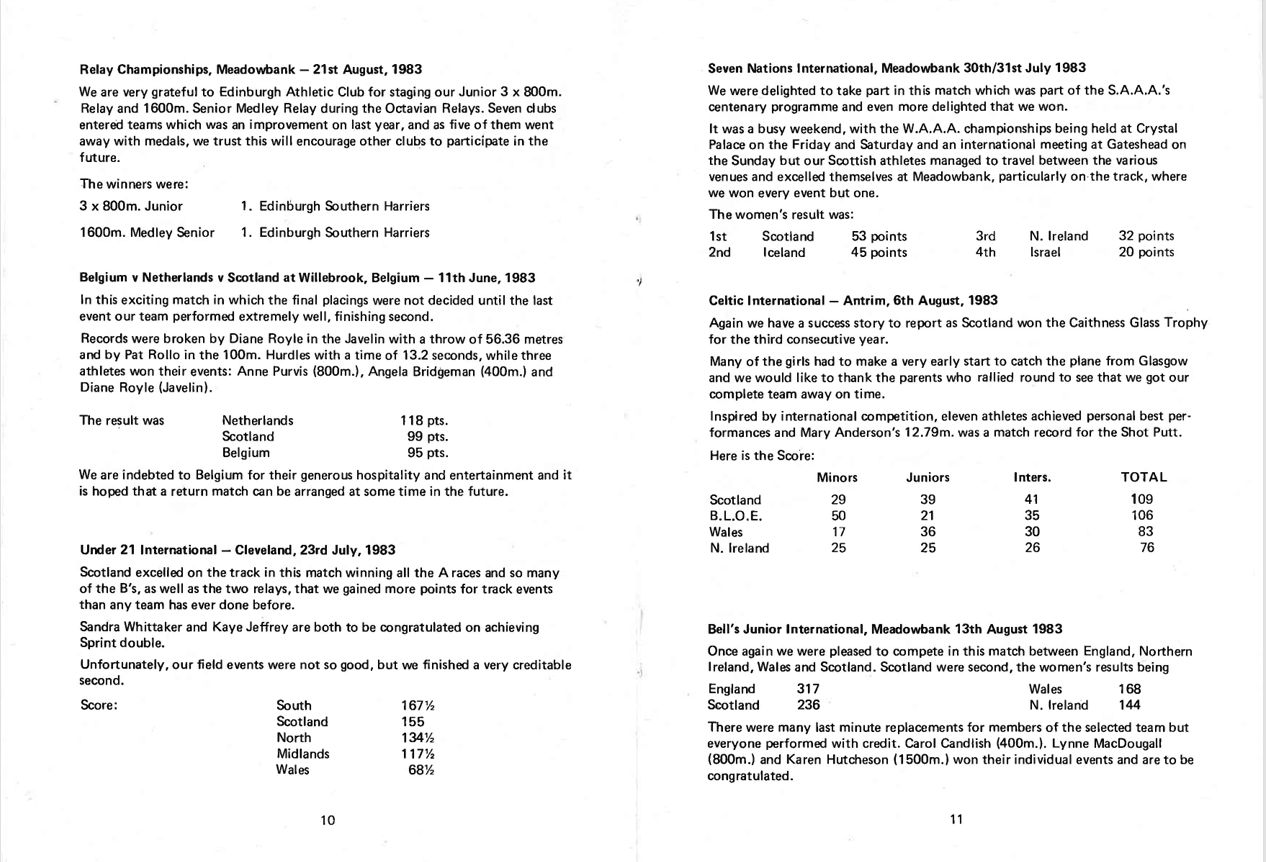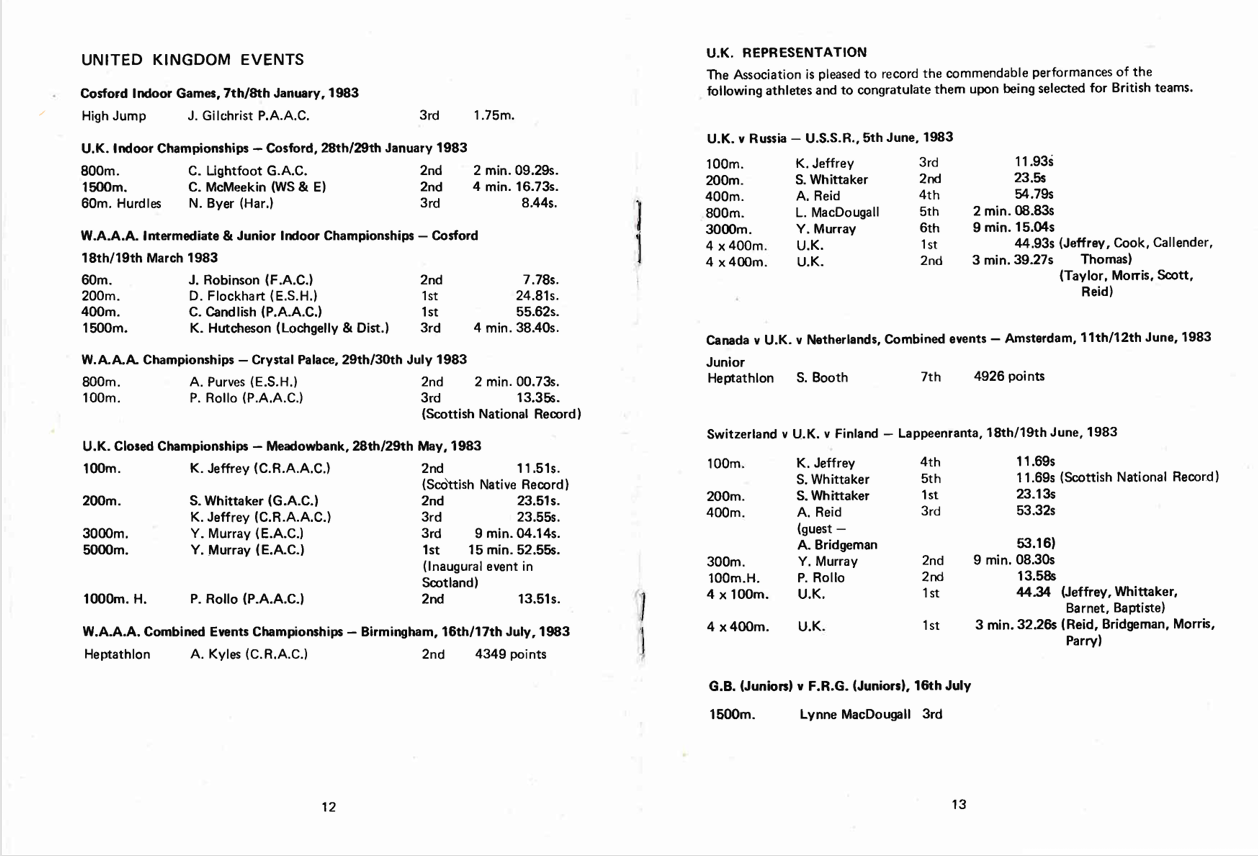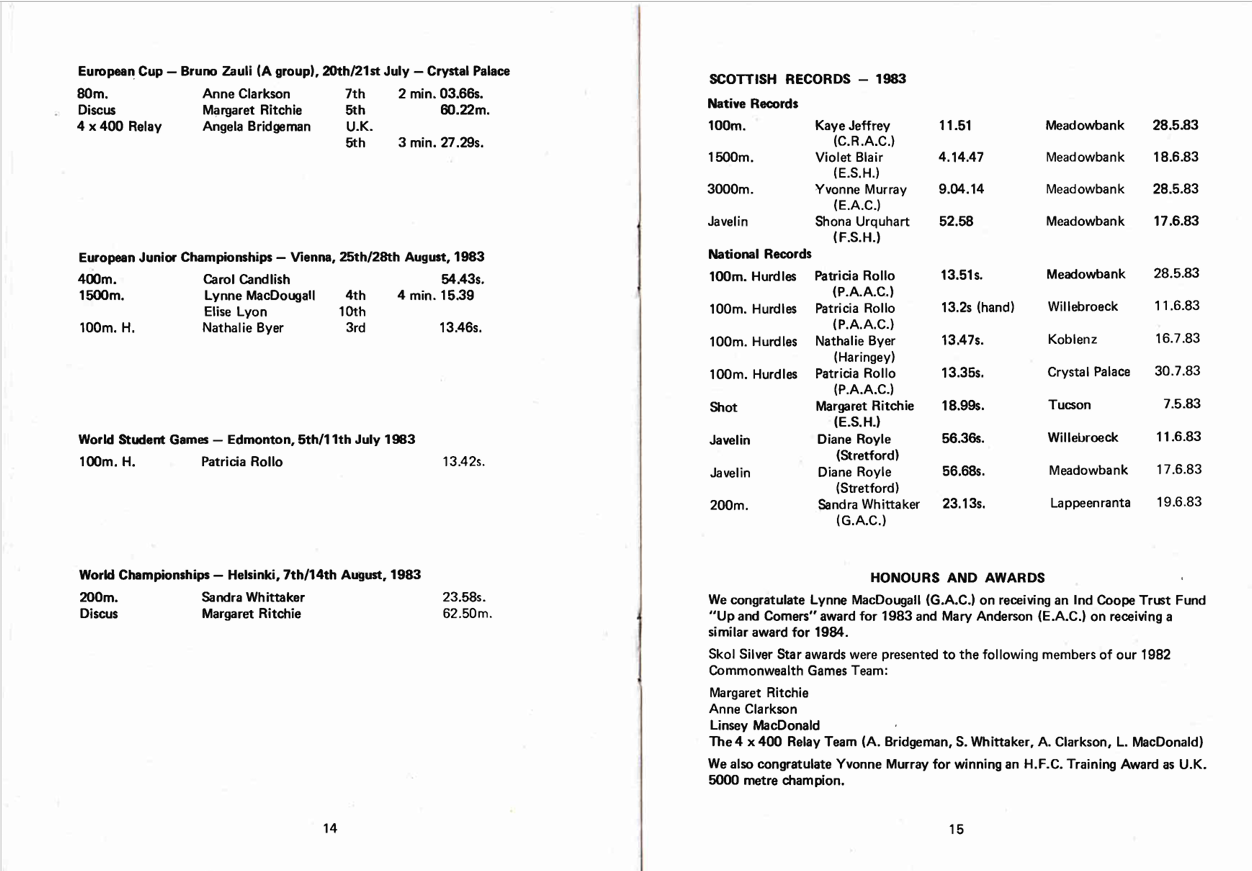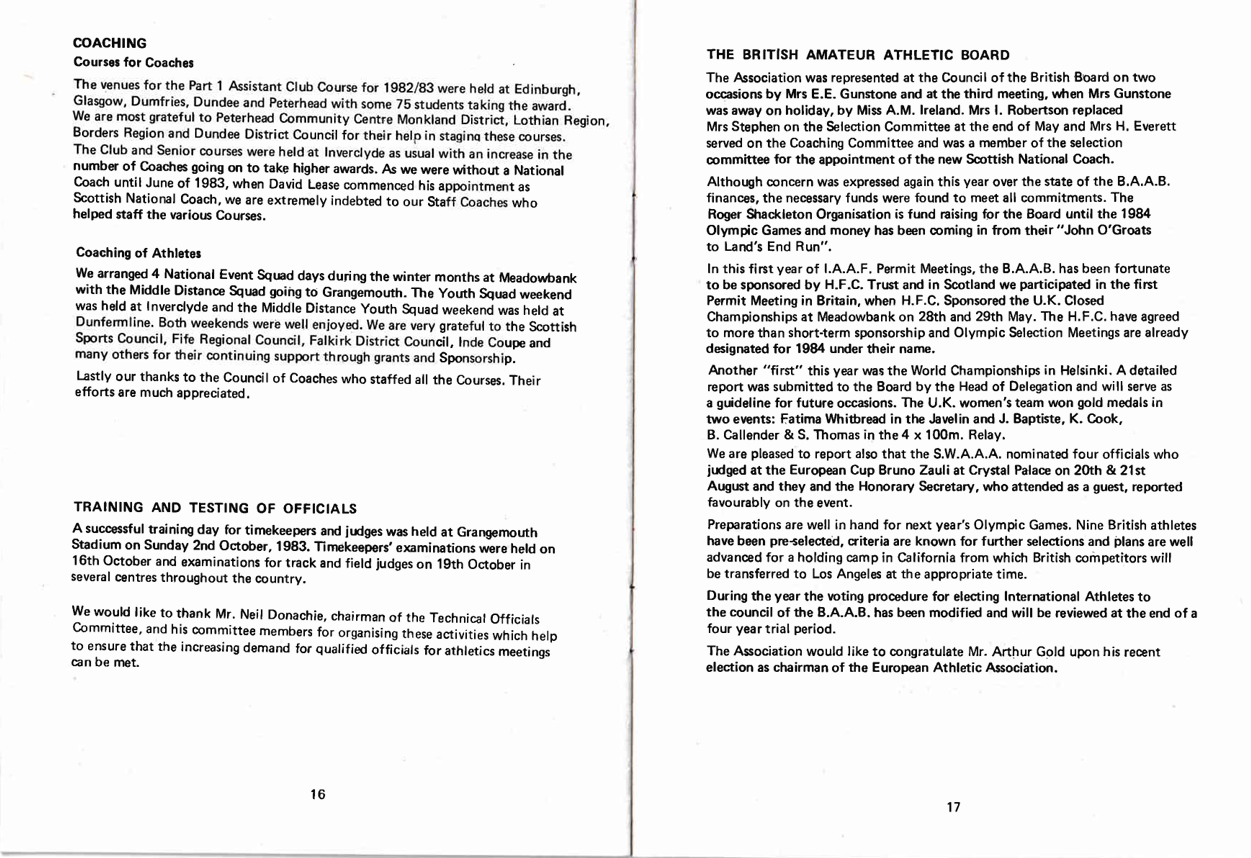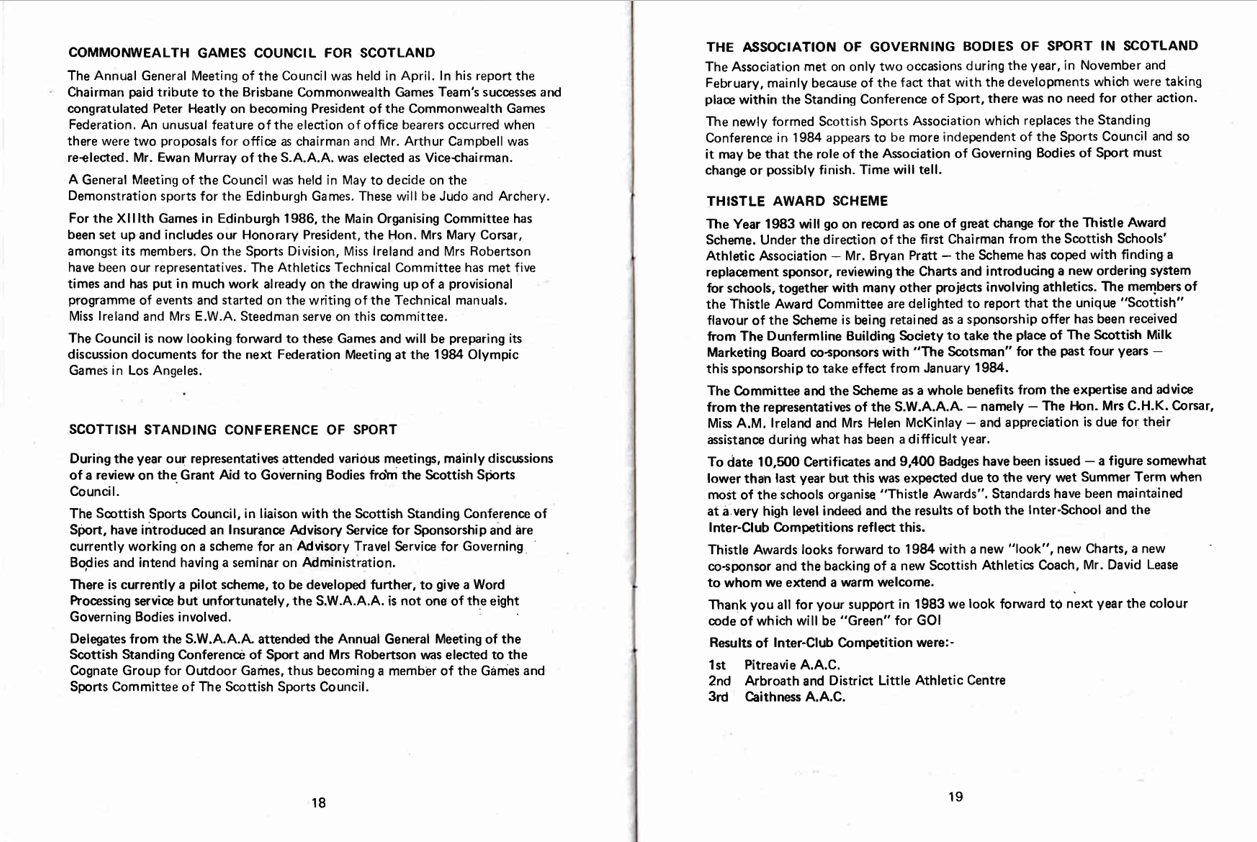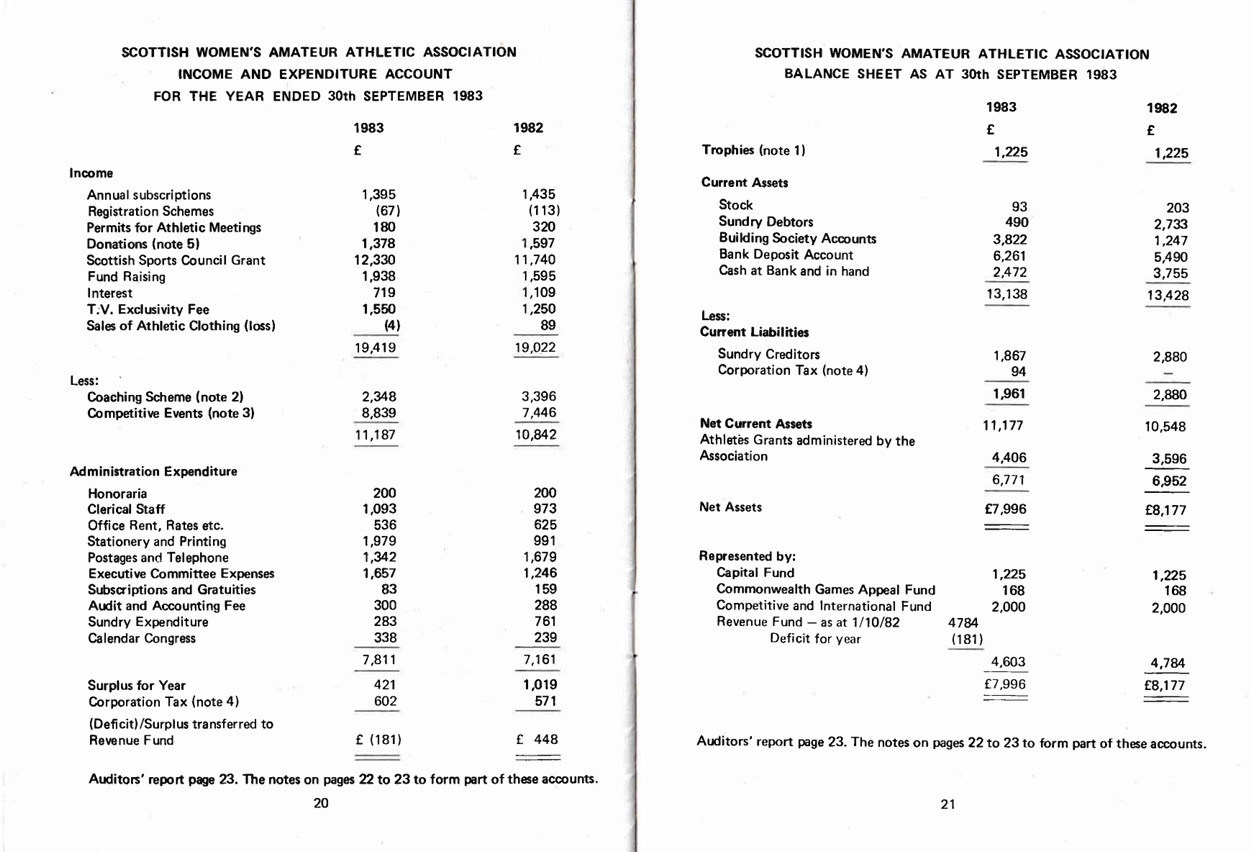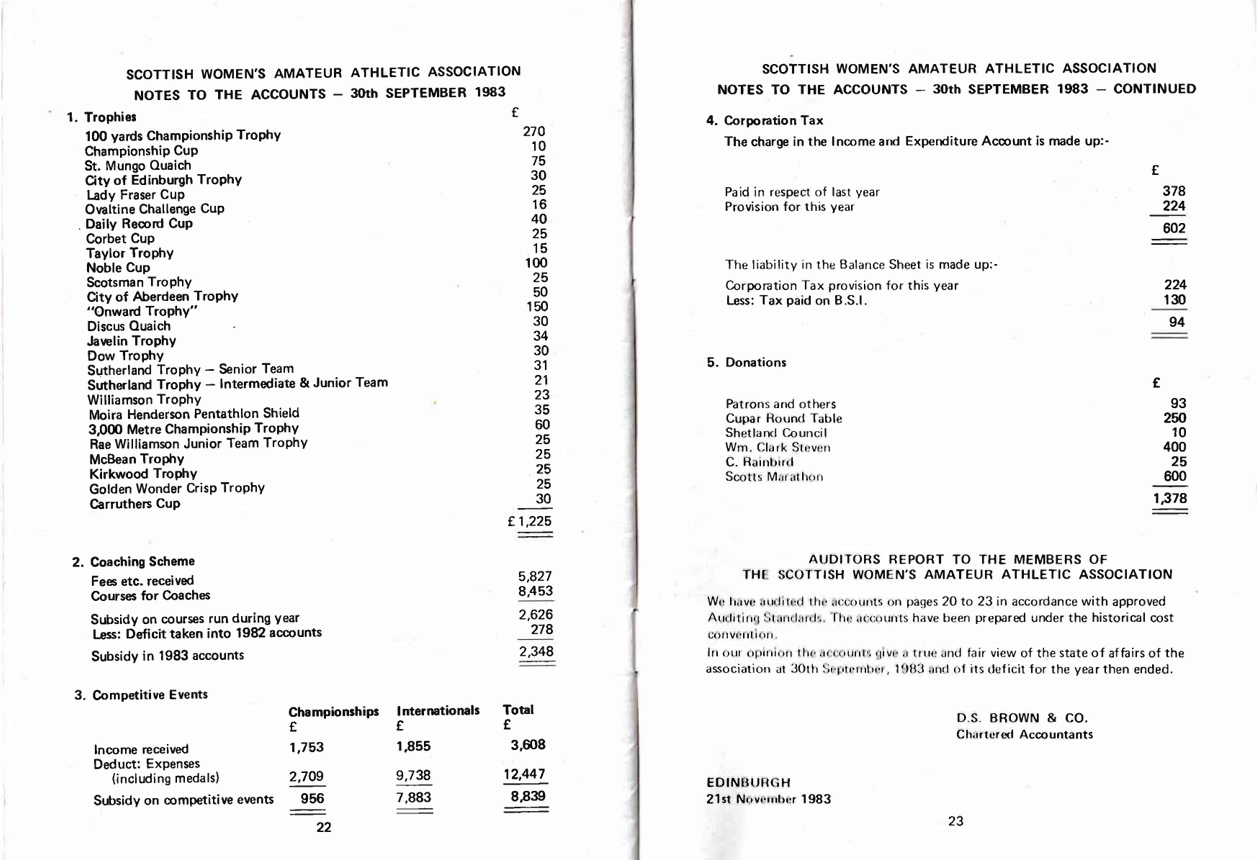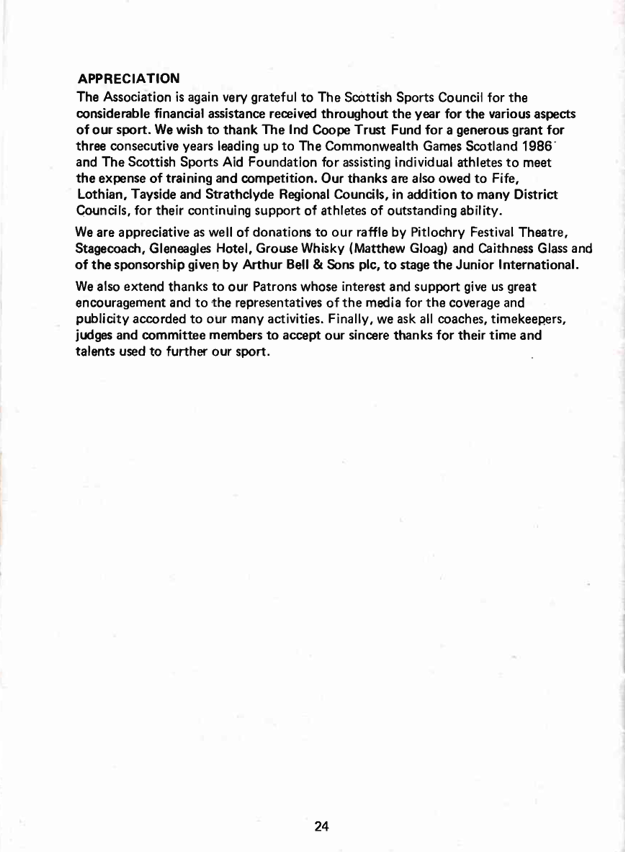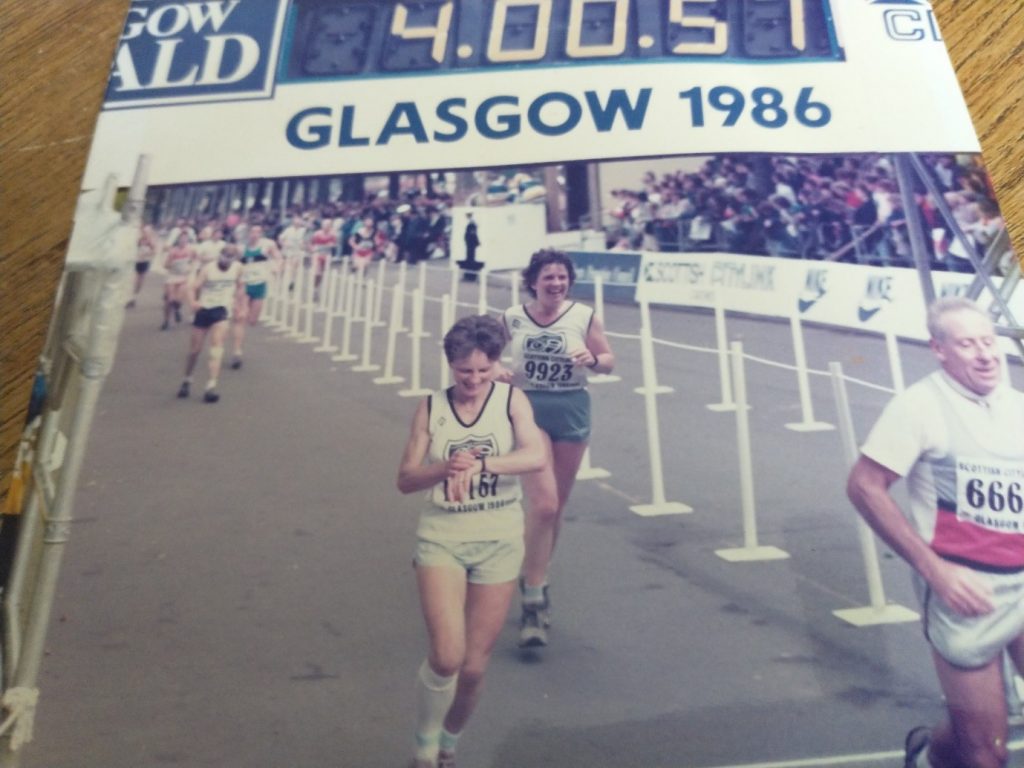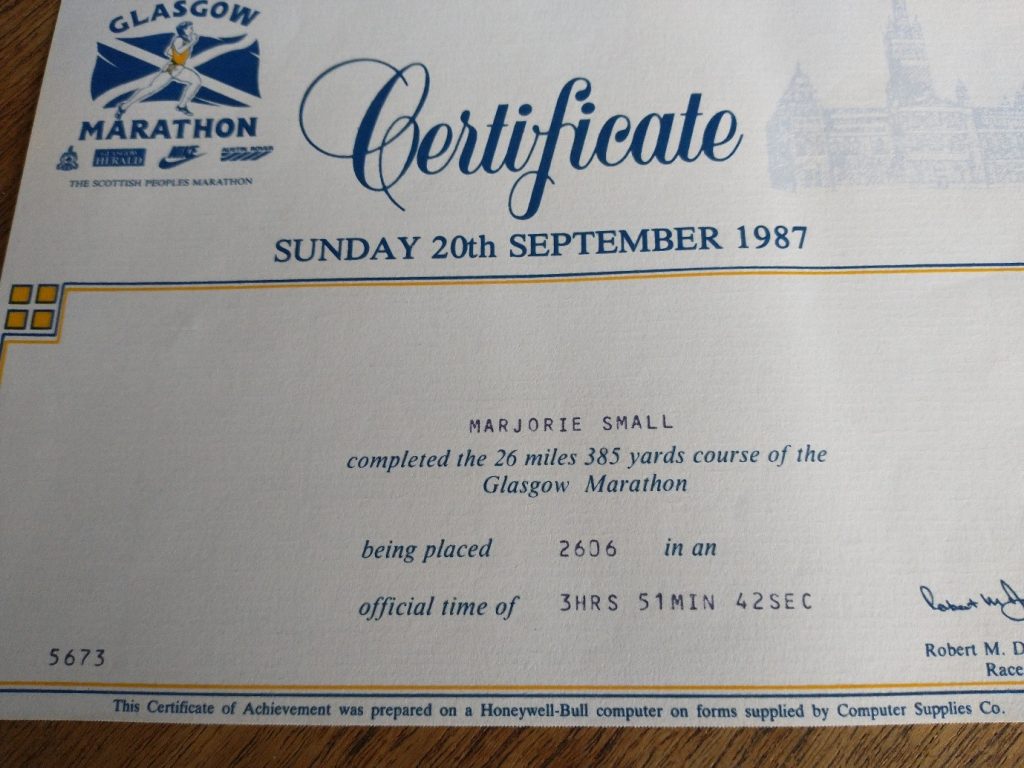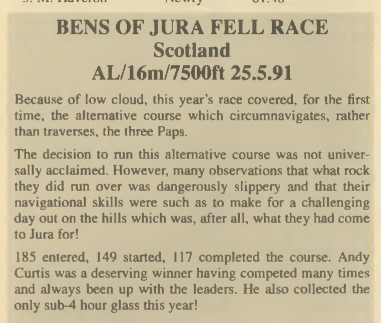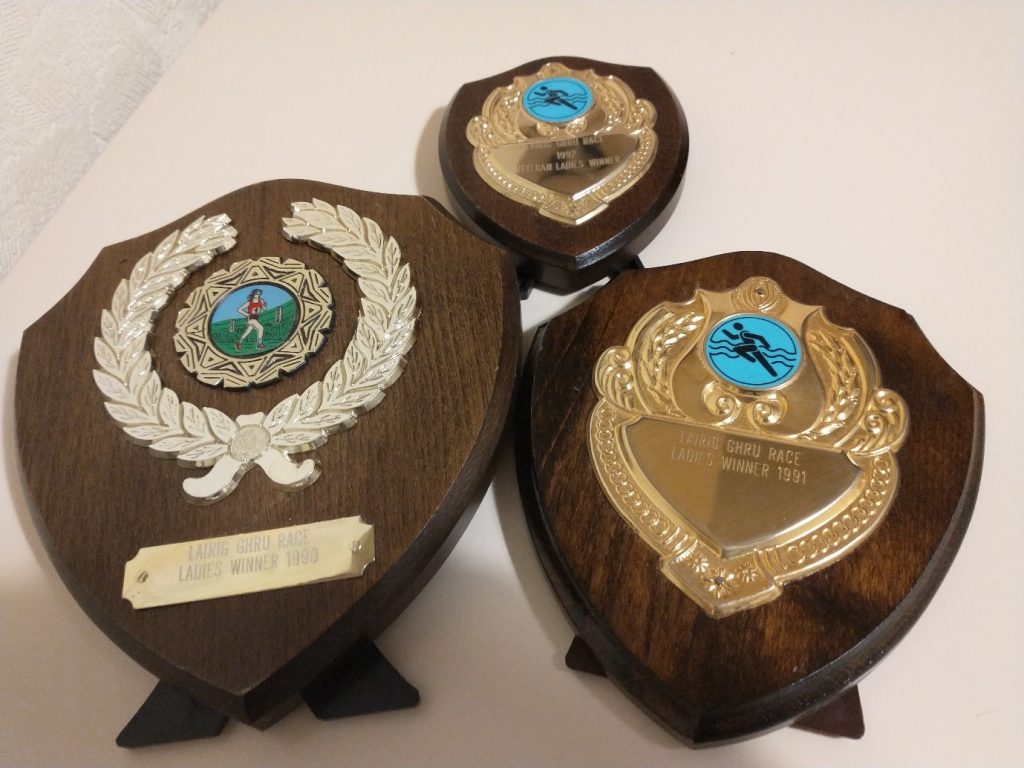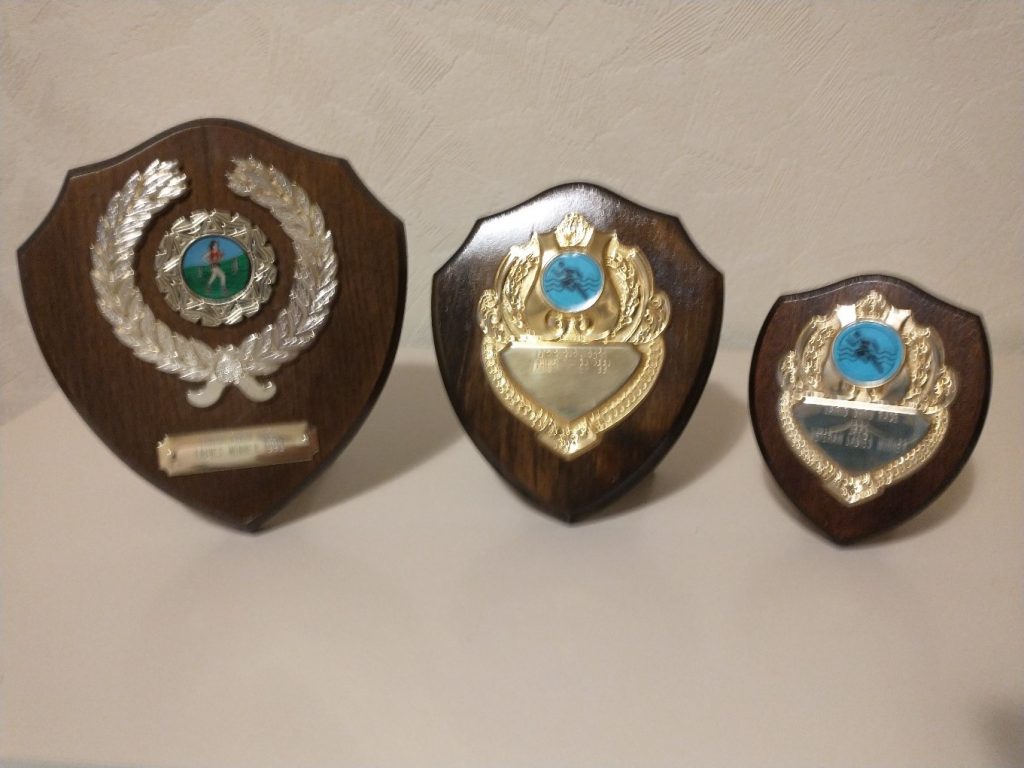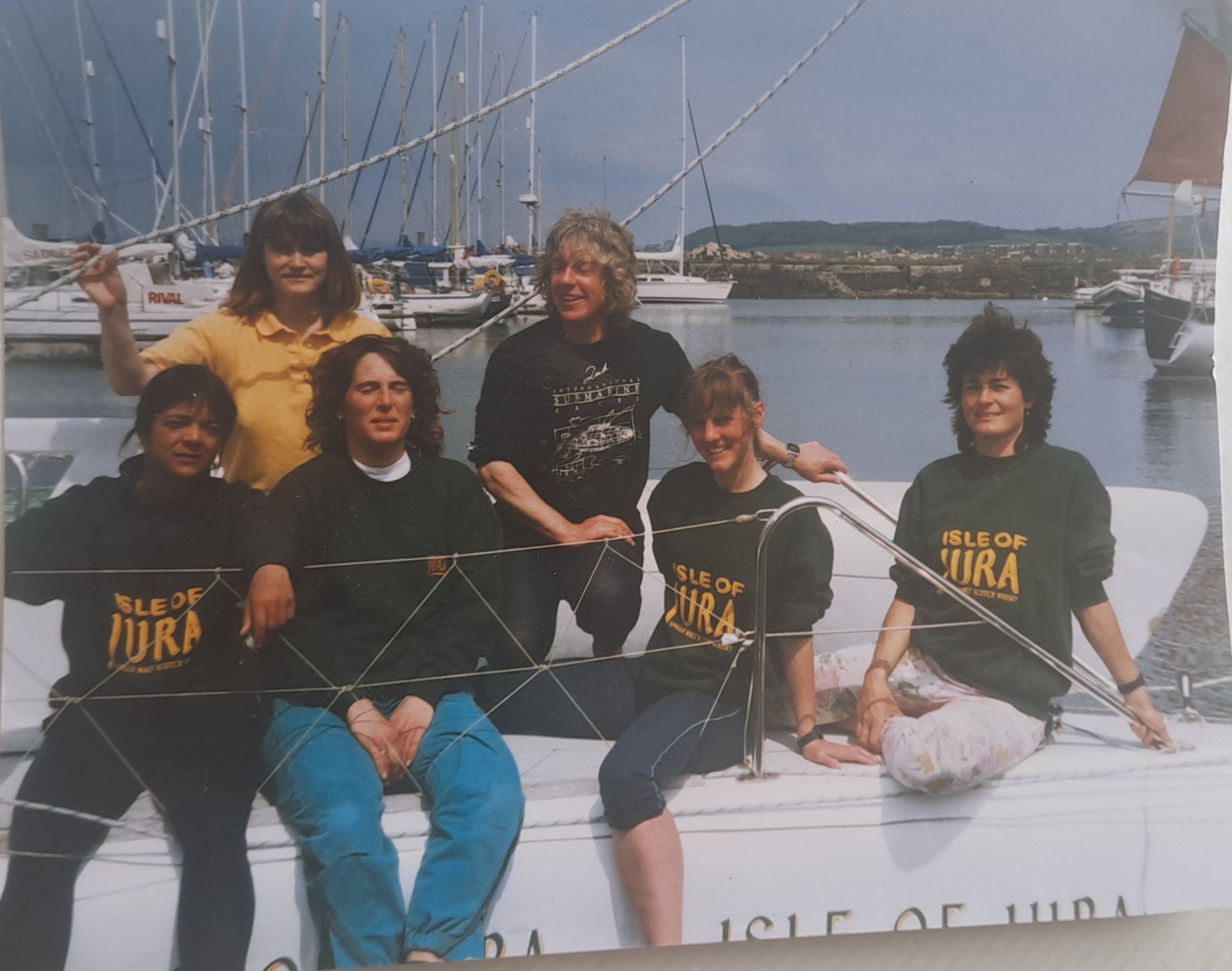
Above is one of Christine Menhennet’s photographs , from 1993,with the women on the right of the front row. Christine says: “Scottish Island Peaks Race the year our all women team came 2nd overall out of a fleet of nearly 70 boats. We were first rounding Mull of Kintyre and up to Sanda ( mainly down to our superfast boat but Helene and I did hold our position in good times on the hill), then wind dies to nothing and we just could not row our big trimaran fast enough – a tiny tri passed us and there was no way we cd catch two top Lake District male runners!”
____________________________________________________________________________________________________________
Helene ran with many partners in the course of her running career. She chose them well – they were all friends and they were all top class runners. As far as the Scottish Island Peaks Race is concerned she ran it with three very good athletes, and in fact donated a trophy jointly with Christine.
Both having run it before, she teamed up with Christine Menhennet, another Scottish International Athlete, in in May 1988. The preview in the Oban Times of 12th May told us that sponsorship had been taken over by Islay malt company Bruichladdich and that the event would take place between May 20th to 22nd with 38 teams taking part – a third more than the previous year. The route of the race is as in the map below – through the streets of Oban, yacht to Mull where the two runners ran up the hills (land route marked in orange), back to the boat which took them to Jura, the runners route is again marked in orange, then on to Arran where the runners route is marked and then sail to the finish in Troon. The sailing course is 160 nautical miles includes the strong tides and overfalls of the Corryvreckan and the Mull of Kintyre, with the runners covering 60 miles including 11,500 ft of climbing. What it doesn’t say is that the runners must carry a sleeping bag, orange survival bag, waterproofs, fleece, tracksters, hat, gloves, map, compass and food!
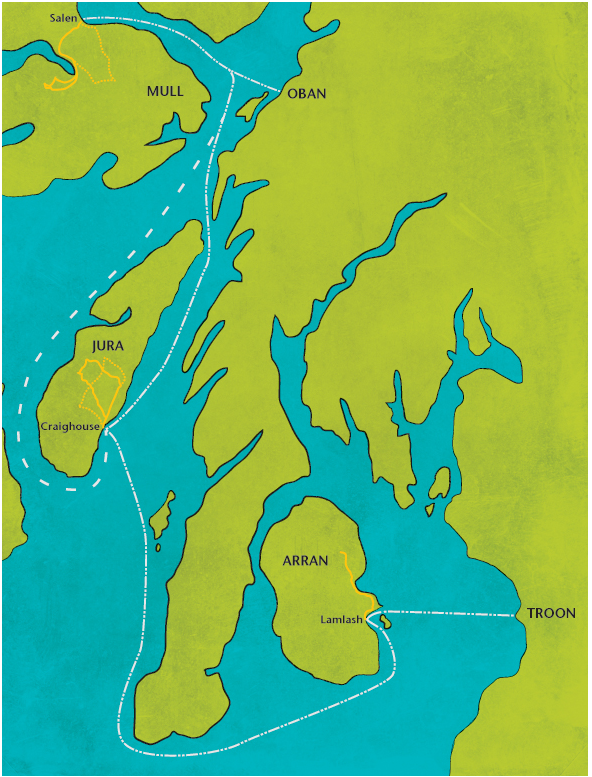
Tom Haley, the company’s marketing director commented on the quality of competitors and after the race the same paper commented further on the sponsor’s all-women team by giving the names of the runners and commenting on the runners from the third placed “Two Hoots” team. “Oban Bay on Friday bristled with masts at the start of the race which saw 76 runners making a quick dash from the South Pier round Pulpit Hill then up George Street to the Esplanade where they joined their yachts for the first leg to Mull. The sponsor’s entry, Bruichladdich, had the added advantage of two runners of the highest calibre: Christine Menhennet and Helene Diamantides, the current Everest-base Katmandu world record holders. Throughout the race winds varied from a 30 knot blow to a flat calm which favoured the lighter craft and the crew of Two Hoots finished exhausted, having rowed 40 miles in 14 hours with only 10 minutes breaks. Two Hoots runners, Brian Potts and Andy Dytch had the fastest aggregate mountain run times.”
The race in 1990 started on 17th May in 1990. Extracts from the preview of the race in the Glasgow Herald are below.
MOLLS OF KINTYRE CAN SHOW MEN THE WAY HOME
“More than 50 craft, a record entry and representing the highest quality in the eight-year history of the event, are scheduled to start at noon. The yachts must flirt with the tidal race at Corryvreckan, which at its most malign will boil and take control of craft even as big as 30ft – about a quarter of the entry in this race. The bravest may even try to harness its power, riding it to take a shortcut as they make for the southernmost tip of Jura. By the time the survivors reach Troon Marina on Sunday the yachts will have covered at least 160 miles, while the two runners on board each will have raced more than 60 miles with climbs totalling 11,500 feet – that is how it looks on the map, but over some of Scotland’s hardest terrain, it works out at roughly the equivalent of three marathons.” and
“Also in action are female runners, including Glasgow landscape gardener Chris Menhennet and Mount Everest veteran Helen Diamantides. It gives great affront to male entrants to have this duo gallop past them on the hills, especially when they do so wearing fishnet tights and feather boas, the self-styled Molls of Kintyre.”
The “Molls of Kintyre title came from a trophy presented by Christine and Helene in 1989 to the first all-women team in the hope that it would encourage female participation. It was called the “Molls of Kintyre” because they had actually competed that year in fishnet tights and feather boas! It’s maybe the best title for a trophy for any race in the country. The race is covered in detail (with pictures) in “Scotland’s Runner” of July, 1990, ( SR No 47.pdf ) .
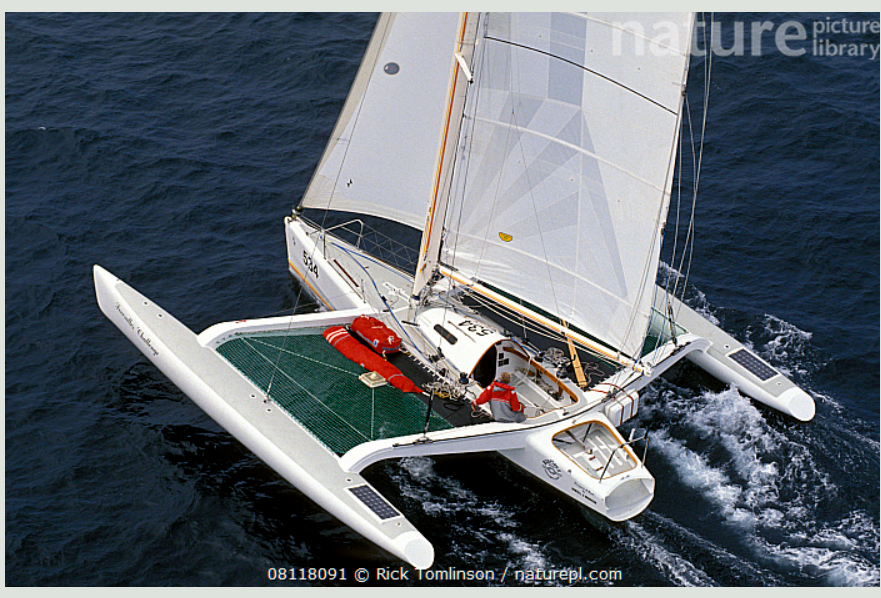
The boats were of different sizes and capable of different speeds with runners competing for the fastest boats. Two Hoots was one of the faster and featured in the results often, but the very fastest was perhaps Severalles Challenge. It was the yacht that Christine and Helene were to sail in in 1993 but in 1990 t runners for it were Martin Stone and Michael McDermott. Their progress (Martin and Michael’s) during the race was, like every crew, slowed considerably by the calm conditions requiring a lot of rowing by the five crew members. The women’s progress was described as follows:
On Mull: The women’s pair of Helene Diamantides and Christine Menhennet recorded a particularly good time of 3:59:59 to best many of the men’s pairs.
On Jura: For the women Diamantides and Menhennet were well ahead with an impressive 4:01:40.
On Arran: By this stage many of the boats were retiring, exhausted from rowing, and simply because they ran out of time and had to get back to work. The Bruichladdich Cheetah, carrying Diamantides and Menhennet, was one of these, and pulled out so Diamantides could be sure to get to a Monday afternoon exam. Sadly they had to do so after reaching Arran before completing the final run.”
The women had run very well indeed and it would have been really interesting (to put it mildly) to see where they would have been placed had Helen been able to complete the final stage.
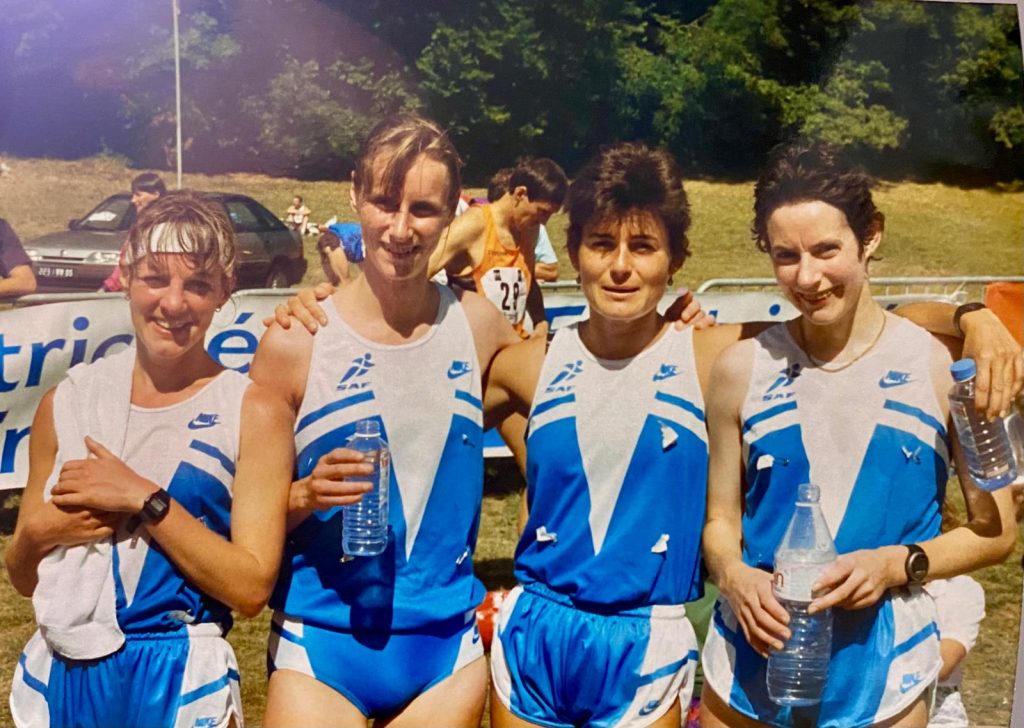
Christine on left with Helene second right
By 1993 they, Christine and Helene, were a well known double act and the preview in the “Scotsman” of 18th May that year is reproduced below since it gives a good picture of the race as a whole. Under the following headline it read:
FIERCE AMBITION OF THE MOLLS OF KINTYRE: WOMEN’S TEAM FACE ONE OF THE GREAT TESTS FOR RUNNERS AND SAILORS.
Stephanie Merry has successfully completed round-Britain and transatlantic yacht races and Helene Diamantides is in the Guinness Book of Records for her mountain-running achievements, but this Friday they will team up for their greatest challenge yet in the Scottish Islands Peaks Race.
Both have tackled the annual Hebridean odyssey many times before, pitting their talents and strengths against the forbidding mountain heights and treacherous tidal waters of the islands. The race covers 160 miles of coastal sailing, visiting Mull, Jura and Arran, where two of the crew of five must run 60 miles across five summits totalling 11,000 feet of climbing. It is a test of endurance few could survive but in the male-dominated worlds of offshore yachting and mountain racing Merry and Diamantides intend to achieve the previously unthinkable. With an all-female crew on the trimaran Severalles Challenge they aim to win outright.
When they leave Oban harbour on Friday they will be aboard a pounds 100,000 yacht which has won the race twice and was purpose-built to do so. The millionaire businessman, Dick Skipworth, who is currently indulging another of his passions by racing his vintage Jaguar on the Continent, has sailed the 36ft trimaran to many victories and offered it to an ecstatic Merry, giving the women’s team a realistic chance of victory.
A 43-year-old lecturer in mechanical engineering at Southampton University, Merry is an experienced offshore racer and has competed in the race four times with an all-female crew though she denies being anti- male. ‘I’ve raced in many mixed crews but am often the only lady as it is very difficult for women to get the necessary experience. Most skippers prefer men for their strength so I like to give women the chance to race. They get on better, aren’t afraid to ask each other for help and are more supportive. Egos don’t get in the way of teamwork.’
For crew she selected Gaye Sarma and Heidi Bell, and the choice of runners was easy. Diamantides has won international mountain races as far afield as Cameroon and Borneo and last year won the 220-mile Dragon’s Back race, beating the world’s best male endurance runners after five days’ racing across the Welsh mountains. Her partner will be Christine Menhennet and between them they have won all this year’s long Scottish hill races. Menhennet recently won the Ben Lomond race and is in the Scottish national team.
Together they hold the women’s records for all the runs to the summits of Ben More on Mull, the Paps of Jura and Goat Fell on Arran, and as veterans know what to expect. Storms and seasickness, rowing when becalmed, landings on slippery, seaweed-covered rocks and trackless terrain are all familiar hazards but the faster yacht makes the task harder. ‘To win we may have to do three 20-mile runs in 36 hours,’ says Diamantides, ‘and the noise and motion of the boat allow little rest. It’s like sitting in a bidet and having buckets of water thrown over you and is the only yacht I’ve been on that gives you a kick up the backside when they hoist the sails. It just takes off.’
Merry views the yacht differently. ‘It has everything you could want, 1,000 square feet of sail, satellite navigation, four batteries with solar charges, even sliding rowing seats. It’s superbly designed and is so fast sailing it is very, very exciting, especially in this race. Crossing the Atlantic is just a journey from A to B but here you’ve got fierce tides, rocks, whirlpools, fickle weather and rounding the Mull of Kintyre to cope with.’
In previous races Merry has suffered with poorly equipped yachts while Menhennet and Diamantides have been grounded, rowed to exhaustion, seen the skipper fall overboard and rounded the Mull only to be pushed back by the tide and forced to do it again. Since then they have been known as the Molls of Kintyre and that name is on a trophy they donated for the fastest women runners. This weekend they aim to win it back and help Merry and crew to victory.”
That was quite a write-up so how did the five women deal with it when the race started in Oban? The “Scotsman” said briefly on the Monday:
“Light winds plagued much of the Scottish Island Peaks Race. Last night only three boats had arrived at Troon Marina, having had to spend long hours rowing and sailing to make progress towards the finish. First to finish at Troon was the 27 foot American build Trimaran Tri Harda skippered by owner Nic Slocum who held off the powerful purpose-built 36 foot trimaran Severalle’s Challenge which was sailed by an all-girl crew.” Having read pre-race that the “all-girl crew” had been skippered by Steph with Helene and Christine as the runners, we knew that they had done very well indeed.
How did the women themselves feel about it? Christine is quoted in “Voices From The Hills” as saying “In 1993 Helene and I were part of another all-women team taking part in the SIPR. Steph Murray was our skipper again and our yacht was the super-fast trimaran Severalle’s Challenge, kindly lent to us by the owner, There were about 60 participating boats that year and we rounded the Mull of Kintyre in first overall position! The wind died and we had to row to Lamlash as a result of which we were passed by the eventual winners, rowing a much lighter boat. Nonetheless, an all-women team were second in to the finish at Troon and we were fifth overall on the running stages out of nearly 50 running teams.”
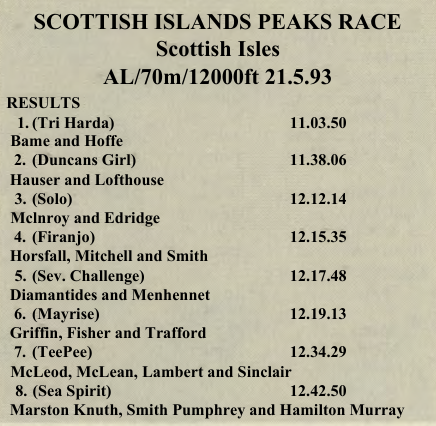
.
However, successful as the pairing was, Christine was not the only partner Helene had for the SIPR. She had two other partners after this with the first being another top rated athlete, Angela Mudge.
A diversion. Coverage of the event has been scanty. Largely because there is limited space on sports pages on Mondays and a three-day event which has two members of a team, a named yacht plus times will take up a lot of space. Editors can only print what they get and even the ‘Fellrunner’ did not publish the results every year although there were several long articles, with photographs, over the years. The same is true of the ‘Scottish Runner’. The actual race website, excellent as it is, only has results going back to 2008. If we go through the British Newspaper Archive, coverage is variable from very little indeed in some years, to a great deal in others – they also stop in the year 2000. There are inevitably gaps in the coverage of the races, and apologies for that.
We take up the event in May, 1996. In 1996 Helene and Angela, in the yacht Matilda finished 3rd overall with a time of 42 hours,28 minutes and 25 seconds. behind English pair K Taylor and J Holt who were first in 39:49:15; Colin Donnelly and A Keith were second in 40:11:26. The second place overall equalled her previous best with Christine in Severalles Challenge in 1993.
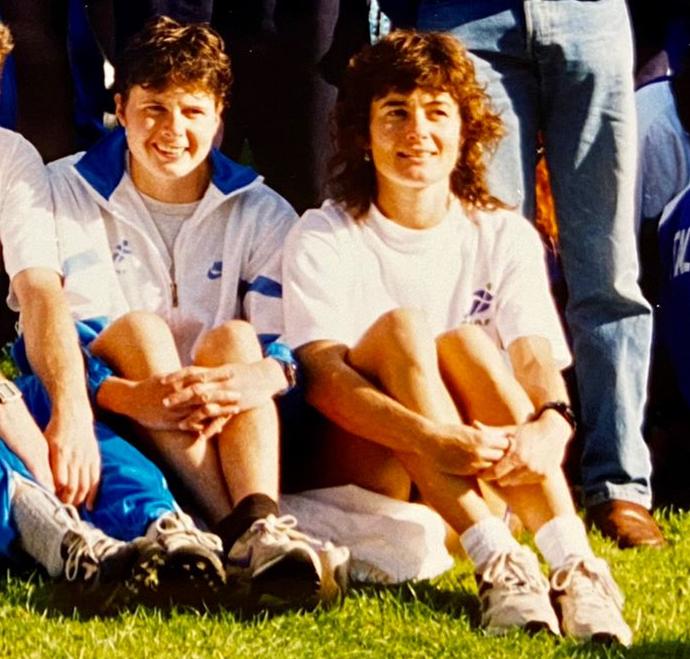
Angela and Helene with Scottish team in 2001
The results for 1997 are not to hand although we know that the Matilda took part. That really tells us nothing because the fast boats like Two Hoots and Kaos were eagerly sought after and may well have had two different athletes on board. We do know however that they were again in action as the runners using the ‘Matilda’ in 1998 when they were third overall in 45:03:21. The winners were D Rodgers and B Rodgers in 43:17:42. Their running time was 11:37:38 to be fourth fastest of the 36 teams that finished. Helene was at that time a member of Fife AC while the King of the Bens were Terry Mitchell and Adrian Devies, also of Fife AC with 11:13:52. There was not a big difference in times given the nature of the terrain to be covered.
They were still together in the race in 1999, this time the boat was HeeBeeJeeBee. The overall winners were J Davies and M Hartell in Kaos with a time of 39:47:11; Helene and Angela were again second team overall but only 28 seconds back in 40:21:15. What we said above about reports of the race was exemplified by the 2000 race which had a two page article on the race by a contestant without any result at the end. Nor were there any results in the Results pages. Why the runner did not pass on the race result to the editor is a bit of a mystery. However we know that Helene took part in abother multi-sport event that year – see below.
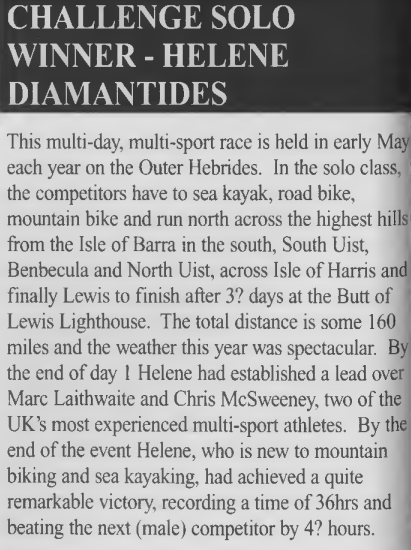
“… new to mountain biking and sea kayaking …. beating the next (male) competitor by 4? hours.
You can’t top that!
